






■
By ISABEL ROSETH EDITOR IN CHIEFStudents gathered in the Shapiro Campus Center Wednesday evening to honor the Palestinians that have died in the ongoing Israel-Hamas war, resulting in impassioned speeches, disdain towards the University and minor conflict with onlookers. The University’s chapter of Students for Justice in Palestine released a statement of return on Feb. 29. The group was derecognized by administration in November “because it openly supports Hamas” and “engage[d] in conduct that harasses or threatens violence,” according to Vice President of Student Affairs Andrea Dine in a Nov. 6 email to SJP. The destruction in Gaza since Israel declared war on Oct. 8 has spurred student activists to action in universities around the U.S., and Brandeis is no exception. In their first public pro-Palestine gathering since the Nov. 11 protest

that ended in the arrests of seven people, SJP and the Revolutionary Student Organization expressed their support of the Palestinian people and their condemnation of Israel.
The Justice reached out to SJP, RSO, Brandeis Orthodox Organization and a Jewish student who witnessed the vigil, but did not receive a response from these sources as of press time.
The violence following Hamas’ attacks on Israel on Oct. 7 has resulted in mass Palestinian casualties as well as numerous Israeli deaths.
As of March 10, Al Jazeera reported at least 31,045 Palestinian deaths in Gaza and 425 in the West Bank, as well as 72,654 injuries in Gaza and 4,650 in the West Bank. About 1,200 Israelis were killed in the Oct. 7 attacks, and of the 253 hostages taken by Hamas, 134 have been released and at least 32 have died as of Feb. 6. Hamas recently reported seven more deaths on March 1 and claimed they were a result of Israeli bombardment. They said at least 70 hostages have died, but it is unclear whether or not the previous 32 are included in that count. 240 Palestinian prisoners in Israel were released in exchange for 105 released Israeli hostages in November.
The event’s organizers began
Elsa Barkley Brown explains the "gumbo-yaya" approach to African American women's quilting.
By GRACE DOHsetting up shortly before 7 p.m. in front of the SCC's main stairwell, reminiscent of the Nov. 7 gathering directly following administration’s decision to derecognize SJP. As organizers handed out flameless tea lights and masks, some set up flags and art pieces, while others donned keffiyehs, a traditional Palestinian headdress. Beside a Palestinian flag, a flag that read “STOP SUPPORTING GENOCIDE” hung from the stairwell’s first landing. Another flag with the words “DOWN WITH COLONIALISM” was duct-taped to the wall. A rendering of the famous Palestinian artwork “Handala,” which depicts a child dressed in rags with hands behind his back, and a student-made art piece entitled “Brandeis Speaks” were also displayed.
Israel has denied and rejected the charges of genocide at the United Nation’s International Court of Justice. The final verdict from the U.N. did not deem Israel’s actions genocide, but ordered Israel to conduct the war such that they “ensure with immediate effect that its military does not commit [genocide].”
RSO and SJP asked community members on March 1 to submit anonymous statements that would be used in “Brandeis Speaks.” The

■ Journalists Adrian Walker and Evan Allen discussed the misled investigation of the Charles and Carol Stuart case.
By MOMOCA MAIRAJ EDITORIAL ASSISTANTOn March 7, the Journalism program hosted a discussion with Boston Globe Associate Editor Adrian Walker and former Boston Globe reporter Evan Allen to discuss their multimedia project “Murder in Boston.” The project included three parts released in December 2023: A nine-part podcast, an eight-part narrative series and a three-part HBO documentary. Both Walker and Allen had lead roles in the project: Walker, who was part of the Pulitzer-Finalist Spotlight team that examined race in Boston, headed the podcast portion, and Al-
len, who was part of the team that won the 2021 Pulitzer Prize for Investigative Reporting for the narrative portion, also participated in the creation of the project. Profs. Ann Silvio (JOUR) and Neil Swidey (JOUR) moderated the discussion.
The project centers on the shootings of Boston residents Charles and Carol Stuart. In 1989, Charles Stuart called 911 and told the police that he and his pregnant wife had been shot by a Black man in Mission Hill in a carjacking. After a prolonged investigation that uprooted the Black community, Charles Stuart’s suicide revealed that he had murdered his wife. The Brandeis Journalism Department wrote in their February newsletter: “The case upended the city, attracted intense national media coverage and ultimately called into question equity issues around race, class and gender that linger to this day.”
“Murder in Boston” covers the stories of those whose experiences weren’t initially reported. Now, See PROJECT, 6 ☛
■ The Justice spoke with the targets of the recent harassment detailed in Chief Rushton’s email.
By RIVER SIMARD JUSTICE STAFF WRITERContent warning: This article includes mentions of sexual harrassment, sexual assault and rape.
A group of Brandeis students were harassed by an unknown suspect outside of the Gosman Sports and Convocation Center on March 8. The suspect yelled offensive and threatening comments at the group and followed them in his sedan. This instance is one of three separate incidents reported to the police. Two members of the group were waiting for the third to join them, before heading to a party that evening. For the protection of those involved, the names of those involved
The Department of Theater at Brandeis just put on their very own performance of "Wolf Play."
By RANI BALAKRISHNAwill not be included in this article.
At approximately 11:20 p.m., as they were standing outside Gosman, a white male who appeared to be roughly 25-30 years old with red hair and a beard drove past the group in a white Ford Sedan. This description has not been confirmed. As he drove by, he screamed a homophobic slur at the group.
The white Sedan returned. This time, the driver threw a plastic bottle at the group. The contents of the bottle are currently unknown.
When the car left again, the group walked east on South Street as originally intended.
After walking approximately a third of a mile from Brandeis, the car returned a third time. The driver yelled, “I’m going to rape you” at the group and left once again.
The group began running on South Street and decided to hide from the man near the Boston Children’s Hospital. Before arriving at the hospital, the car pulled up to the group again and the man yelled, “I’m going to murder you.”
The group hid and one member
See HARASSMENT, 6 ☛
MEYERIn its March 10 meeting, the Student Union Senate observed a presentation from Secretary Carol Kornworcel ’26, who had been working on updating and revising the official Student Union Constitution. These amendments include changes to the composition of the Senate, Allocations Board, Judiciary and Executive Board, along with revisions to the elections process. All of these proposed changes will be publicly available in the future, presented to clearly demonstrate both the changes made to the current set-ups and the reasoning behind these changes.
These are currently proposed changes and an ongoing discussion. The Senate will be voting on these changes on March 17, so it can be voted on by the student body before the 22nd. The Constitutional Review committee will rewrite these changes, which will be presented to the Senate again at a later date. General spring elections will be one round after these amendments have been voted on by the student body.
The proposed changes to the Senate Constitution include one additional senator per class, putting the total at three which includes a midyear representative serving a seat from January to December. There will now be an additional two senators at large, raising the number from two to four, with the plan of electing two in the spring and two in the fall. Finally, the remaining senator is intended to
MEDICAL EMERGENCY
be an international student. The total number of voting members is expected to decrease from 24 to 17. These changes, which include the removal of racial minority, Myra Kraft Achievers Program (formerly MKTYP), and housing representatives respectively reflect legalities from affirmative action, an absorption of responsibilities by the E-Board director of Outreach, and the intention to no longer limit senators to focus only on their own quads.
In regards to the Allocations Board, the proposed changes decrease the number of voting members from eleven to seven. There will be six elected representatives (four elected in the fall, two in the spring) serving two semester terms instead of three, one senate representative, one DSE staff representative and two co-head treasurers elected internally. In changing the three-semester removal policy, Student Union hopes to eliminate the inconsistency behind such an irregular term. The removal of the two racial minority representatives once again stems from the legalities around affirmative action. Furthermore, a smaller-sized group is able to be more directly involved with students during the yearly spring marathon.
The Judiciary Board, currently consisting of five associate justices (with the Chief Justice internally elected out of the five) and one Clerk of the court will be dissolved due
to its lack of utilization. Instead, a committee of E-Board union members, with at least one year of Union experience, will be created if a situation arises.
Students can expect to see the E-Board removing the Community Enhancement and Emergency Fund and Campus Sustainability Fund representative positions, which will be managed internally through A-Board and various other union representatives. Furthermore, two representatives will be delegated to the Board of Trustees and Undergraduate Curriculum Committee to ensure close work between the two chairs and direct communication with the E-Board.
Finally, the proposed changes to the elections process include an amendment that the president, vice president, secretary and head treasurers may not be permitted to study abroad during their term. Fall elections will see a decrease in the number of available positions to run for, with the eligible positions including two first-year senators, two senators at large and four A-Board representatives. The winter and spring elections will see a similar set of changes.
Senator Cameron Sherman ’26, co-chair of the Dining Committee, presented the first Senate Money Resolution of the night, discussing the concerns students have raised about allergies. After talking to dining administration, the current plan is to provide stickers to
Mar. 1—There was a medical emergency for a student who was not feeling well. They refused medical treatment.
Mar. 6—There was a medical emergency for a community member. They were transported to a local hospital.
Mar. 6—A caller reported that they were having a medical emergency. They were transported to a local hospital.
Mar. 7—A community member had an allergic reaction. They were treated by BEMCo staff and transported to a local hospital. The area coordinator on call was also notified.
SUSPICIOUS
Mar. 2—A community member reported that a white vehicle slowly passed them, and the suspect stated that they were going to assault the caller. An officer is to speak with the community member, and there will be an investigation to follow.
Mar. 3—A caller requested assistance with an unwelcome party on campus. The subject left the scene before the police arrived. An investigation is to follow.
■ The Judges by the Numbers column on pg 15 had the incorrect source of information for Track and Field statistics. It was supposed to be from the most recent meet, at the Tufts Last Chance (March 5, p. 15).
■ Caption for the Brandeis admissions photo on page 10 had a mispelled name. Instead of ANDREW BAXTOR, it should be /ANDREW BAXTER (March 5, p. 10).
■ Caption for Brandeis Involvement Fair photo on page 10 had a mispelled name. Insted of CECI XIELI CHEN/ The Justice, it should be CECI XILEI CHEN/The Justice (March 5, p. 10).
The Justice welcomes submissions for errors that warrant correction or clarification. Send an email to editor@thejustice.org

scan a QR code on that will take people directly to the menu. Each sticker will essentially serve as a link to the menu specific to each dining hall and its various sections. The Senate passed a vote by acclamation to confirm this SMR.
Senator Sahil Muthuswami ’24, chair of the Health and Safety Committee, brought attention to the upcoming event Tea with Teddy, intended to bring attention to the Brandeis Counseling Center with the help of a service dog named Teddy, who will be present. The Senate passed a vote by acclamation to confirm this SMR.
Upcoming club presentations are something to look forward to in the week of March 17, with multiple clubs preparing to present in hopes of gaining probationary status.
— Ariana Rich
— Editor’s Note: Justice staff writer Ria Escamilla-Gil ’27 and Justice Editor Rani Balakrishna ’25 are Student Union senators and did not contribute to this article.
Mar. 2—An individual reported that they were minimally struck by a vehicle. The Waltham Police Department responded, and the situation was cleared.
Mar. 5—There was a minor motor vehicle accident. An investigation is to follow.
Mar. 1—A caller reported vandalism in a building lobby. There will be an investigation to follow.
Mar. 1—An instance of harassment was reported in a residence hall. An investigation is to follow.
Mar. 4—There was graffiti reported in a men’s restroom. An investigation is to take place.
—Compiled
by Sophia De Lisi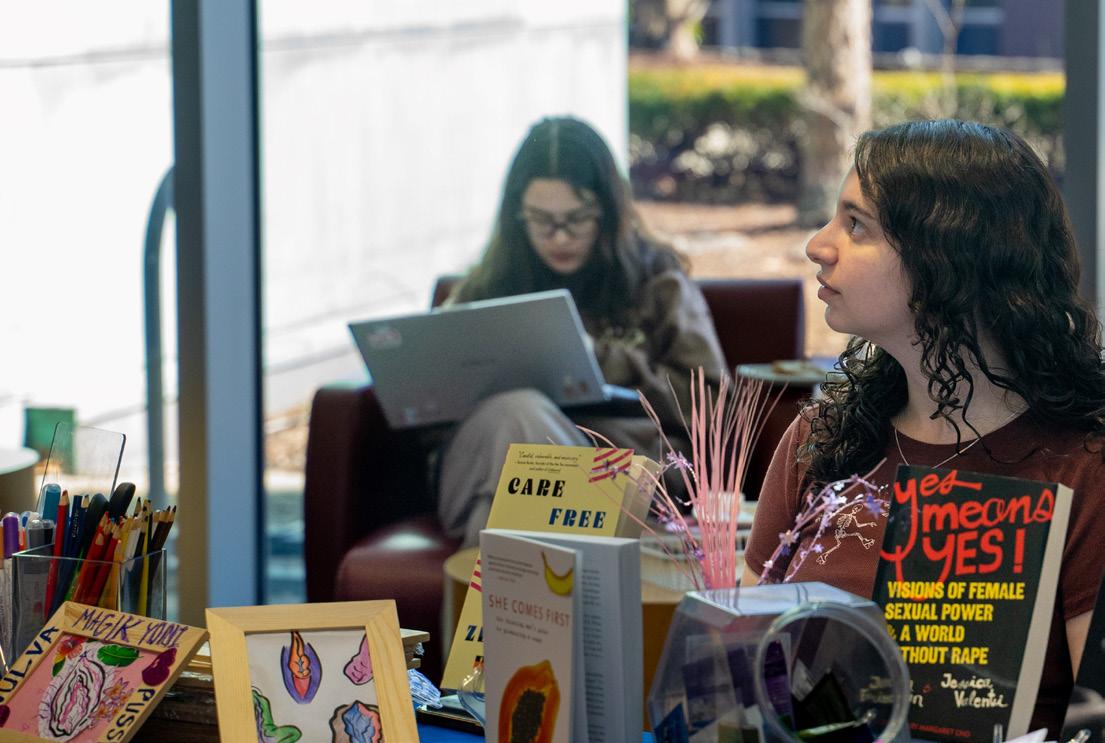




■ The annual Diane Markowicz Memorial Lecture featured the expert in international law and human rights.
By LIN LIN HUTCHINSON JUSTICE EDITORIAL ASSISTANTContent warning: This article includes mentions of rape.
On March 10, the Hadassah-Brandeis Institute hosted its annual Diane Markowicz Memorial Lecture on Gender and Human Rights, featuring Dr. Cochav Elkayam-Levy. The lecture, titled “War Crimes Redefined: The Oct. 7 Attack by Hamas on Women, Children and Families,” centered on Elkayam-Levy’s expertise in international law and human rights and her experience as a founder of the Civil Commission on Oct. 7 Crimes by Hamas Against Women and Children.
Elkayam-Levy began her lecture by quoting Catharine MacKinnon, American feminist legal scholar, activist and author: “Human rights have not been women’s rights — not in theory or in reality, not legally or socially, not domestically or internationally. Rights that human beings have by virtue of being human have not been rights to which women have had access, nor have violations of women as such been part of the definition of the violation of the human as such on which human rights law has traditionally been predicated.” Elkayam-Levy emphasized that the values and ideals enshrined in international human rights discourse does not encapsulate the realities and experiences of women, especially during times of conflict.
“Coming from Israel, I can say in the midst of atrocities, international law seems meaningless,” said Elkayam-Levy. “It seems so far from our realities that it’s even painful in many ways.”
As the Oct. 7, 2023 war between Israel and Hamas continues, more and more questions, criticism and discussion regarding the potential international human rights laws being violated by both sides began to be raised. Sparked by what she had seen on Oct. 7 and the legacy of the Holocaust, Elkayam-Levy was the principal author of the National Report on Gender Mainstreaming in Times of Emergencies, which she describes to have “Revealed the depth of women’s exclusion from the decision making process.” Elkayam-Levy elaborated that women’s voices are being left out of important decision making circles, “which time determine the life and death of all of us.” In June of 2022, the Israeli government adopted the report.
During her lecture, Elkayam-Levy shared a personal anecdote of the days before and following Oct. 7, where her father was in the hospital. While visiting her father, reports began pouring in reflecting the effect of the initial Oct. 7 conflict. “In the very first days … I personally didn’t realize that there is going to be an issue with the international community,” Elkayam-Levy remembered. “I didn’t think that we were going to see the kind of dynamics that we saw after the seventh of October.”
Elkayam-Levy became dissatisfied with the lack of response from international human rights organizations. Along with other women and experts of international law, she founded the Civil Commission on Oct. 7 Crimes by Hamas against Women and Children that the HBI describes as “an independent, non-governmental collaboration of international human rights experts and women’s rights organizations created to advocate for and support the investigation of war crimes committed by Hamas against women and children during the massacre of the seventh of October 2023.”
Elkayam-Levy claimed that with what she
and her colleague were able to collect, they have shared the information to every United Nations agency that is involved with women’s and children’s rights. To her dismay, no agency responded. “For days, for weeks we waited. We sent them again and more and more information … It was kind of a sad experience to know that we were struggling for them to just respond to what happened,” Elkayam-Levy said. Elkayam-Levy was hoping that the response would have included initial reporting of the situation at hand, expressed solidarity with the victims, condemned the crime and offered help in amplifying the victims voices.
On Oct. 31, Elkayam-Levy was invited to speak to the U.N. Committee on the Elimination of Discrimination Against Women. According to Elkayam-Levy, nothing much came of her talk with the U.N. “I want to say their silence has implications,” said Elkayam-Levy.
“It is dehumanizing. I think the haunting question that kept repeating in my head for weeks later is ‘are we Israeli women even human?’ With lack of satisfying results, Elkayam-Levy and her colleagues ended efforts in communicating with international organizations and instead continued their work in documenting incidents of human rights violation against women.
“I told [colleagues] we have a historical mission to document and collect every piece of information regarding what happened to women,” Elkayam-Levy said. “I began to understand that we have a role in keeping every information we got, every report, and I knew this was our only chance to keep a historical record of what happened.”
Beyond international human rights with respect to gender, Elkayam-Levy briefly worked to redefine international human rights laws to include children and families.
“The targeting of family is a new practice that should really concern us all,” Elkayam-Levy shared. “It is a news practice that redefines crimes against humanity and requires our most urgent action.”
After Elkayam-Levy’s lecture, there was an Q&A portion to the event, which was moderated by Lisa Fishbayn Joffe, the Shulamit Reinharz Director of HBI.
An audience member, who identifies as Israeli, challenged Elkayam-Levy by adding to the discussion that they believe that “the crimes against humanity of Oct. 7, should not be weaponized as saying ‘We have the right to conduct this war.’”
“I completely agree,” Elkayam-Levy responded. “I think the human suffering that we are seeing is putting us in an impossible situation. The suffering we are seeing on both sides of the border is intolerable. It must be recognized, it must be understood on both sides … I think we have to talk about what is happening in Gaza.”
Joffe followed up asking if there is any collaboration between the work that Elkayam-Levy does with people who are tracking sexual violence against Palestinian women.
Elkayam-Levy responded by discussing how she and her colleagues use accounts from first responders, morgue staff and survivors in collective information. It is unclear to The Justice if those same method of data collection is used to collect information on sexual violence against Palestinian women. She elaborated, “This is something that needs to be addressed. This needs to be addressed by the IDF. It needs to be addressed by civil society. There are also academics in Israel that are raising their voice against it and I wanna say this has to be investigated by the IDF and government.”
“Justice begins with recognition,” Elkayam-Levy said. “Justice begins with the ability to acknowledge what happens to the victims and also healing being with recognition.” In reflecting on how to start moving forward, Elkayam-Levy sees the value of recognition and sees this as an important first step in the potential for conflict resolution.

■ The educator and writer was recognized for intersectional disability and reproductive justice advocacy.By DIANE MEYER JUSTICE CONTRIBUTING WRITER
Content warning: This article includes mention of rape.
On March 7, Brandeis awarded activist Robin Wilson-Beattie the second annual Carrie Buck Distinguished Fellowship Award. “In social justice movements, disability rights are often an afterthought,” remarked Wilson-Beattie in her opening comments. Yet this recognition of her career in advocacy pertaining to the intersectionality of disability and reproductive justice is a step toward giving this often ignored issue a critical space for discussion. When embarking on her career in educating and speaking up for disability rights, Wilson-Beattie says she was often “told that this wasn’t possible.” Now this award is “a dream manifested” through funding her work and calling attention to the systemic ableism in reproductive health policy.
The award reception on March 7 was structured as a conversation titled “Accessing Reproductive Justice: Using Intersectional Self, Systems, and Community Advocacy to Create Inclusive Sexual and Reproductive Healthcare and Expression.” The discussion was hosted in the Heller School for Social Policy and Management and provided a space for conversations that celebrated both success and potential.
Wilson-Beattie says that the importance of the disability rights movement and the work of Black women with disabilities are often forgotten by mainstream social justice movements. She expressed an emotional realization that this award was her first time being recognized and celebrated for her work, saying that it was “life changing,” and “not only validating for recognizing scholarship and research around disability and sexuality, but validating for [her]... [and proves] that [her] work is important and needed in this area.”
Celebrating the legacy that the Carrie Buck Distinguished Fellowship hopes to build involves recognizing Brandeis’ history and involvement in disability and reproductive rights. Rebecca Cokely, the event’s moderator and the Disability Rights program officer for the Ford Foundation, which funds the fellowship, is partly to thank for the fellowship’s creation. Two years ago, during a celebration of her own work where she received the Richmond Distinguished Fellowship Award, she cited the Supreme Court case Buck v. Bell as an important reminder of how the Brandeis community is deeply tied to disability and reproductive justice.
Carrie Buck, for whom the Fellowship award is dedicated, was involuntarily sterilized after the Court’s ruling in the case of Buck v. Bell, allowing the state of Virginia to codify their 1924 Eugenical Sterilization Act. Prior to this case, Buck was raped by her foster parents’ nephew. Following her pregnancy she was committed to the Virginia Colony for Epileptics and the Feeble Minded, an isolated government-run residential hospital. Five months after giving birth to her daughter, eugenicists then decided to use Buck’s situation as a reason to legitimize Virginia’s sterilization law. This
verdict, which effectively enabled the forced sterilization of people with disabilities, was signed by Justice Louis D. Brandeis in an 8-1 majority vote. Though a century ago, the Buck v. Bell case demonstrated the systemic ableism present in American society, especially in its healthcare and legal systems. As Cokely remarked, “the topic of sex and disability is still taboo,” which impedes the ability for work to be done in this necessary intersection of healthcare and social justice.
As a Black, disabled mother, Wilson-Beattie has faced her own personal struggles when dealing with the American healthcare system. Inappropriate care and inadequate support from doctors has threatened her reproductive rights and her bodily autonomy. During her conversation with Cokely, she remarked that “in order to exist in society you have to be compliant … [to] authority … [and make] your body convenient for able bodied people.” Cokely added on by noting that “you are never more vulnerable than when you’re on the doctor’s table,” and the marginalization of disabled women, especially disabled women of color, makes the healthcare system a dangerous place to navigate at times.
The conversation was far-reaching in its inclusion of topics that are sometimes considered taboo by educators and in social justice movements. Cokely noted that the seeming unwillingness to talk about sex and disability is largely due to ideas surrounding “the notion of who is deserving and undeserving in [social justice] conversations.” Wilson-Beattie agreed, pointing out that systemic problems revolving around “deciding who gets to have sex, [and] what kind of sex [people] should be having,” while “encasing it in a cloud of questions and secrecy” makes both sex and disability controversial in mainstream society.
Ongoing inequality is especially evident in education, but teaching is also where the most potential lies for productive change. Wilson-Beattie believes that “comprehensive sex education needs to be mandatory for all students.” In addition to implementing better sex education in general, disability-inclusive sex education is necessary and involves “meeting people where they are, [and] adapt[ing] and accommodat[ing] for how they learn to teach them about their bodies and their rights and health.” This equitable approach to sex education is integral to giving young people with disabilities the means to understand and protect their reproductive rights. Wilson-Beattie also stated that “changing how we define sex … and pleasure” through a typically heteronormative lens is essential.
When asked about what the reproductive justice movement can learn from the disability justice movement, Wilson-Beattie called for the “inclusion of the voices of the most marginalized [people] in positions of leadership.” As she put it, “identity impacts how we get to navigate the world” and recognizing the important work of Black women throughout history, who are often the voice for what is happening but not given authority to take action, is especially crucial in regards to reproductive health.
The power of discussion is principal to Wilson-Beattie’s work in making social justice spaces more inclusive and intersectional. Including and uplifting voices of the disability rights movement is fundamental to the ultimate goal of intersectional reproductive justice, which in Wilson-Beattie’s words, is “reproductive happiness” for all bodies.
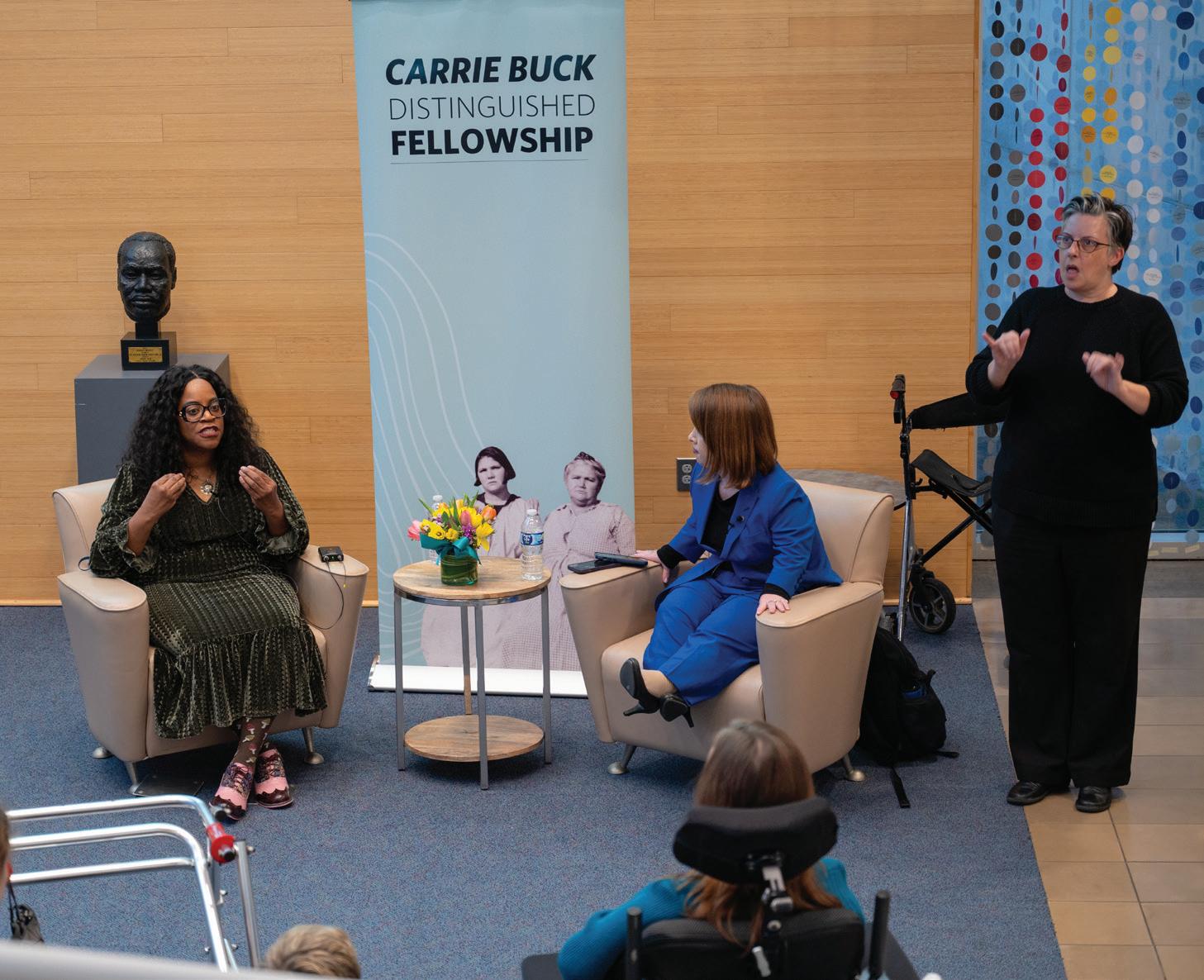

WOMEN’S
■ Alumni return to Brandeis to speak with students about what it means to be a woman in a leadership role.
By KELSEY STEVENS JUSTICE STAFF WRITERIn celebration of International Women’s Month, the Business Department partnered with the Hiatt Career Center’s Rise Together Mentor Network and Forté Foundation, a female leadership program, came together to present a Women In Leadership Alumni Panel on March 7 at the International Business School. Six influential female alumni joined students to share their experiences in leadership positions and how to navigate male-dominated fields.
Emily Chou ’24, a Business Undergraduate Department Representative, organized this event. When Chou attended a Forté Foundation conference last semester for women and business, she found herself surrounded by like-minded women in the business field, which is a traditionally male-dominated industry. She was then inspired to organize this event allowing students to connect with female leaders.
One of the featured alumni was Chastity DeLorme ’14, a program manager for Strategy and Transformation at Pegasystems and winner of CRN’s Women of the Channel Award in 2021. DeLorme oversees the governance of Pegasys-
tems’ strategy and the initiatives that support it. Erica Granor ’15 is a product designer at Markforged, where she designs on-screen interactions on industrial 3D printers. Christine Phan ’14 is a senior business analyst at King Arthur’s Baking Company. Irina Gaziyeva ’22 is a project/program coordinator at the Massachusetts Institute of Technology Startup Exchange, where she fosters collaboration between MIT-connected startups and corporate members. Blanca Rodriguez ’22 is an analyst at Berkeley Partners, where she identifies and underwrites investment opportunities. In attendance also was Stephanie Yan ’19, an associate at Northpond Ventures.
Chou asked the alumni a series of questions ranging from what it means to be a woman in leadership positions, how they grew into their leadership roles and the biggest advice they have for students.
Throughout the event, DeLorme emphasized the importance of trying new things and bringing more diversity to the workplace. She encouraged students to “[recognize] the differences that [they] bring and the power of those differences,” and remarked that everyone can “bring [something] a little bit different” to the table.
DeLorme commented that she was often told that she was too informal or that her emails were too flowery. She advised students to find someone they trust and filter through the feedback — feedback that is supportive and feedback that is critical. Additionally, she discussed the importance of finding a support group but also taking your own unique path: “Do not compare your
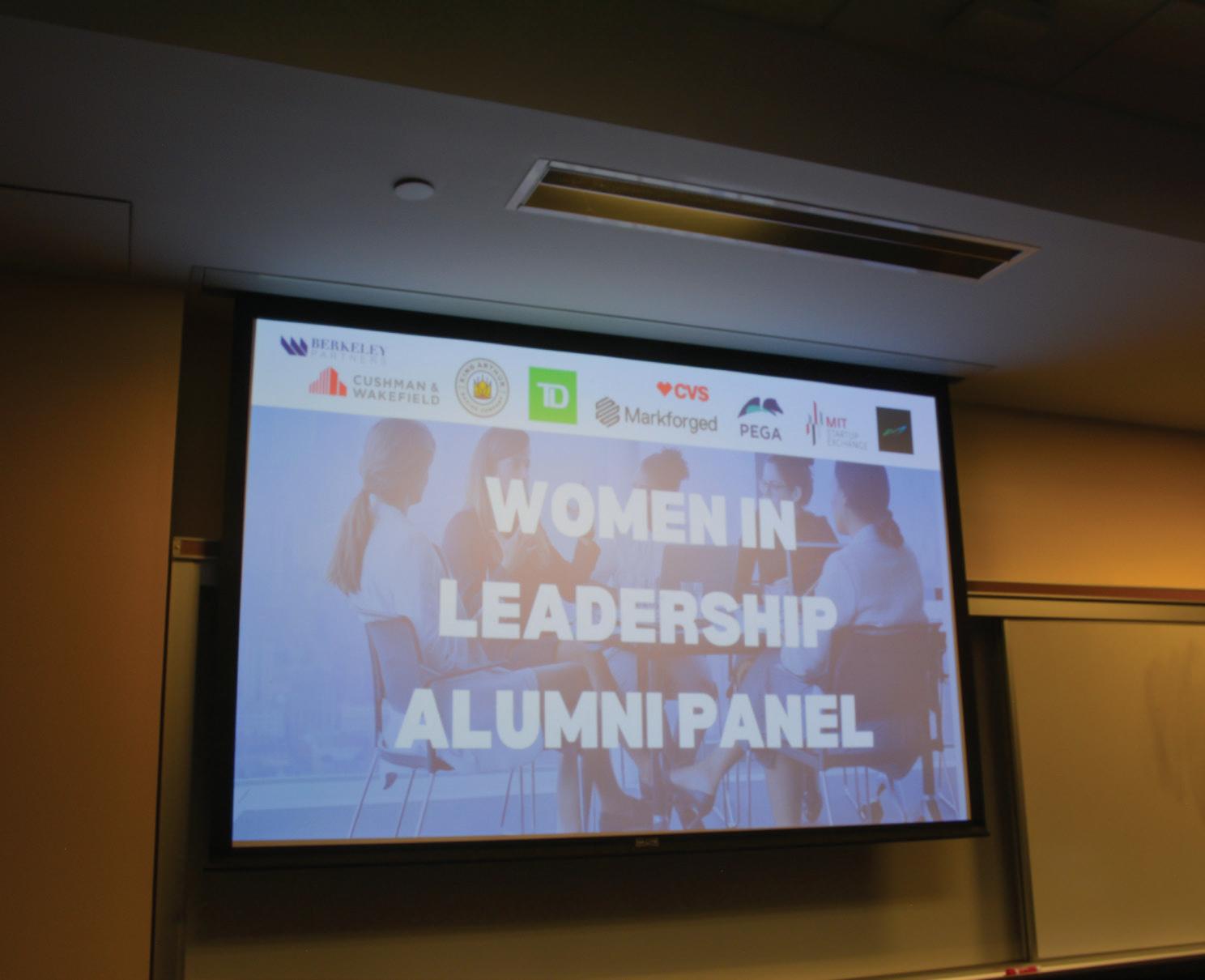
March 5 was Super Tuesday, with voters in 15 states and one U.S. territory choosing the candidates they wished to run for president. This particular day sees the highest number of primary elections nationwide until Election Day in November, according to The Associated Press. The votes accumulated from Super Tuesday are then tallied and awarded delegates, who then represent their respective communities at the presidential nominating convention, to select which presidential candidate will represent their party on the official election ballot. For a presidential candidate to win their party’s nomination, they must win the majority of delegates.
CBS News reports that there were 865 Republican delegates available and 1,420 Democratic delegates available on Super Tuesday, with prospective candidates having to win 1,214 delegates out of 2,429 and 1,968 out of 3,934 delegates respectively.
Former president Donald Trump won all GOP primaries, only losing Vermont to the former governor of South Carolina, Nikki Haley, by a 4.3% difference. Haley’s losses on Super Tuesday pushed her to conclude her run for the presidency less than two months after she began.
In a March 6 statement, Haley commended Trump for his victory, but did not offer him an endorsement. “I congratulate [Trump] and wish him well. I wish anyone well who would be America’s president,” Haley said. In her remarks, Haley referenced the advice of the first female Prime Minister of the United Kingdom, Margaret Thatcher: “Never just follow the crowd, always make up your own mind,” she reiterated.
“It is now up to Donald Trump to earn the votes of those in our party and beyond it, who did not support him, and I hope he does that,” Haley said. “At its best, politics is about bringing people into your
journey to others.” In order to make a difference in the world, women need to support one another through their unique journeys.
When asked what being a leader means to her, Phan discussed the stereotype of needing to be loud and assertive in the room. However, as a quieter person, she emphasized redefining leadership, telling the audience to “Redefine what leadership means to you, what success means to you.” For Phan, this approach means being a kind and empathic leader.
Adding on to the other panelists, Rodriguez mentioned that part of being a leader is taking initiative and thinking outside the box. Rodriguez reminded students that when entering a new position, regardless of what field, beginners in their career will not know everything and that it is important to figure some things out themselves.
Later in the event, Phan discussed the importance of learning how to take a compliment, and how it is difficult for some women to take compliments. She also advised students to find work-life balance early on and not sacrifice mental health for a job. All the female panelists highlighted the importance of sticking true to themselves throughout their careers.
Granor mentioned the importance of showing up as well as finding a support group earlier in one’s career. She commented on imposter syndrome, the feeling of being out of place even if you are outwardly succeeding. She explained how if a person receives a position at work, they were probably picked for a reason, especially af-
ter a tough interview process. Sharing similar sentiments as Granor, Rodriguez discussed the mindset of imposter syndrome and how it is entirely internal: “You are your worst enemy.”
“We are enough,” Gaziyeva said. She discussed the feeling of failure and the importance of getting back up everytime and highlighted the importance of being present in the moment even when it is easy to get overwhelmed.
Yan expanded on how, in a male-dominated field, it is important to find people to feel like you belong. Yan discussed receiving feedback, especially when students are starting their careers or in new roles. One set of feedback Yan received frequently at the beginning was that she was not confident enough, saying that many women receive this feedback. She said not to take it personally or take offense to it. Yan advised students to find a mentor, someone they can confide in, and a sponsor who actively supports them in their next role or challenge. The importance of networking and keeping in touch with people from previous jobs was something Yan promoted.
Gaziyeva highlighted the importance of asking for help and receiving feedback as well. Gaziyeva informed students to be self-aware and not afraid to ask questions or ask for support. She told students to “Be brave; take little steps.” After the questions students were given an opportunity to network with these alums.
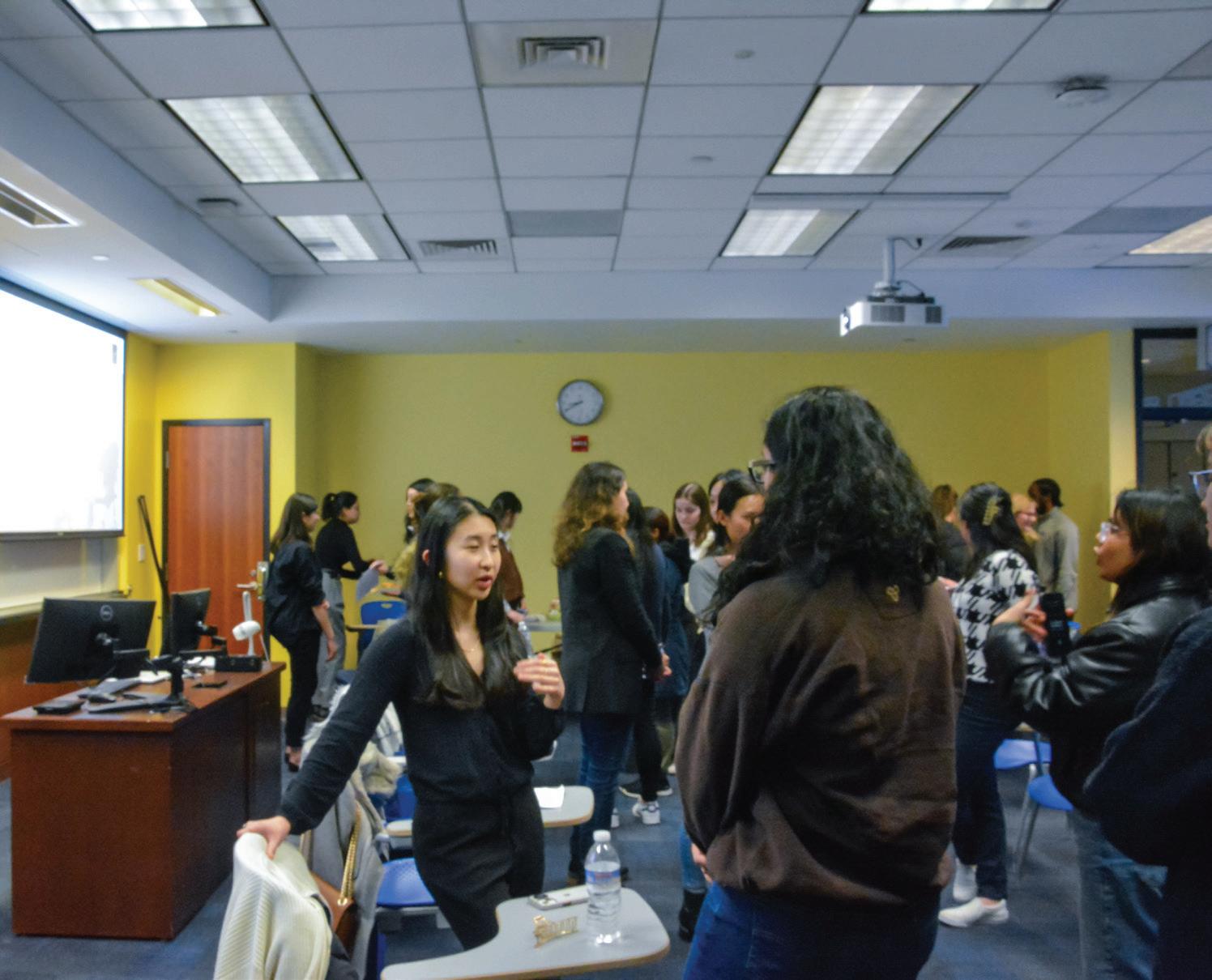
On Feb. 29, Vice President of Diversity, Equity and Inclusion
cause, not turning them away, and our conservative cause badly needs more people. This is now his time for choosing.” She concluded her speech with an excerpt from The Book of Joshua and thanked the country. President Joe Biden won all 15 Democratic contests on Super Tuesday except for his loss against Jason Palmer in the American Samoa primary. Haley’s exit sets up the U.S. for a re-match between Biden and Trump.
The New York Times states that this election will be the United States’ first presidential re-match to take place in nearly 70 years. The last instance took place between Dwight D. Eisenhower and Adlai Stevenson in 1952 and 1956, according to the Pew Research Center.
“[The election] will be an eight-month slog, with two nominees who polls show are deeply unpopular and who are each determined to make the race about his opponent, leaving both bent on running exceedingly negative campaigns,” noted the same NYT article.
This trend was illustrated by President Biden’s State of the Union Address on March 8, where he referred to Trump 13 times, referring to him as “my predecessor” at each instance, AP said.
Despite Biden and Trump’s sweeping victories in Super Tuesday, neither has received enough delegates to become their party’s official nominee. As of press time, Trump is short by 140 delegates, and Biden is missing 102..
Sophia De Lisi
Dr. LeManuel Lee Bitsóí sent an email to the Brandeis community about celebrating “the contributions and achievements of people with disabilities” in March. The email wrote that over 20% of undergraduate students at Brandeis identify as having a disability, and over 25% of Americans have a disability. Dr. Bitsóí states that the practice of dedicating March to Disability Inclusion, Equity and Accessibility at Brandeis began last year.
The email detailed the history of rights for people with disabilities, particularly the passing of the Rehabilitation Act in 1977, which prohibited discrimination against people with disabilities in programs and activities receiving federal funding; the Americans with Disabilities Act in 1990, which prohibits discrimination against the disabled in general; the Individuals with Disabilities Education Act in 1990 that required a “‘free appropriate public education’ for students with disabilities;” and the Supreme Court’s decision in Olmstead v. L.C. in recognizing the right of people with disabilities to live independently.
Despite these significant strides toward equality, a stigma associated with disabilities and an inadequate execution of enforcing these rights remain. Consequently, Dr. Bitsóí stated that by having
a month dedicated to inclusivity, “we strive to recognize and support genuine movement against the forces of exclusion, marginalization, and invisibilization of [people with disabilities].”
Multiple students have noticed Brandeis’ lack of accessibility to those with physical disabilities, as seen through its many non ADA-compliant buildings and lifts that often break down.
Still, Dr. Bitsóí emphasizes that systemic change can increase inclusion: “Access and inclusion can then be approached less in terms of individual alterations and adaptations and more in terms of new ways of building and sustaining spaces, processes and relationships that welcome all people.”
Brandeis will be hosting multiple events this month to acknowledge and educate students and faculty on disability justice.
From Feb. 26 to March 4, there will be a Disability Day of Mourning display in the Heller School for Social Policy and a workshop on disability justice for those entering the workforce on March 15, as well as other events during Neurodiversity Celebration Week from March 18 to March 24.
— Momoca MairajCONTINUED FROM 1
of the group called 911. As they waited for the police to arrive, the group watched the car pass by several times, but he appeared to not see the group. Approximately 10 minutes later, Waltham police arrived at the scene. The group provided information regarding the encounter. They said that once they returned to campus they felt much safer.
Several students posted information regarding the suspect on the anonymous app Sidechat, primarily detailing that he was in a white sedan
and harassing women. There were claims that he got out of the car and went up to the group or pinned them down and threatened to pull a gun out. The Justice has not been able to corroborate these claims as of press time.
The following evening, the University’s Chief of Police, Matthew Ruston sent an email to the community entitled “INFORMATIONAL: Timely Warning - Active Investigation of Threat(s).”
The email began by discussing how there have been several instances on campus over the past
few days of “verbal threats, abuse, and physical aggression.” Rushton provided student safety recommendations: stay aware, travel in groups, utilize campus resources such as the blue light system and Brandeis Public Safety’s phone line (781-736-3333) and report incidents to campus police.
“I don’t feel necessarily extremely concerned to go out, but it has definitely opened my eyes up about campus safety. Obviously walking at night through Waltham is a risk, but what kind
CONTINUED FROM 1
with access to an abundance of materials, the mistakes made by the media — particularly between the Boston Globe and Boston Herald, — act as a guiding lesson to future journalists. The event included a Q&A portion for audience members and aired the trailer of the HBO documentary.
While the Stuart Case unfolded many years ago, its impact on Mission Hill continues to today. “The biggest surprise was that 33 people knew about it … and just how botched the police investigation was,” Walker said.
The extensive history and past reports on the Stuart Case allowed Allen and Walker to explore the nuances of the case. TV coverage was accessible and drove the story, as well as unorganized boxed materials from federal court. Listening to tapes that they remastered to CDs of Black teenagers being interrogated about the crime “felt like you have gone further back in time than 1989,” Allen said. They were also able to recover sources from people who had saved materials such as grand jury transcripts, the files of disbarred attorney of the Bennett family — of one of the wrongfully accused Black men Willie Bennett — that had been donated to Northeastern University and
the police report from the District Attorney.
The making of the “Murder in Boston” podcast required a different approach from the narrative series, as a podcast couldn’t include testimonies from deceased people who weren’t previously interviewed or written sources. Casting was a large part of the documentary and required individuals who were both compelling storytellers and connected to the story.
The speakers emphasized how the voices from Mission Hill community were essential to the project. Through methods such as comparing voting records from 1989 to 2022, identifying who still lived in the neighborhood and knocking on potential interviewee’s doors, they slowly gained trust of members in the community. “We were constantly in Mission Hill … by persistently being there, you establish that you’re not just driving by. You’re here for real,” Allen said.
The team encountered numerous ethical dilemmas during their two and a half year project. Midway through their project the Boston Globe team learned that HBO, their partner on the documentary, had paid the Bennetts for their interview. They were uncertain on
of made it more shocking is that it was literally in front of Brandeis,” a member of the group said in a March 11 interview with The Justice.
At the time of publication, no suspect has been publicly named.
Chief Rushton did not respond to The Justice’s request for comment as of press time.
— Editor’s note: A member of The Justice’s staff was a witness and did not contribute to or edit this article.
whether to move forward with their project as paying for an interview violates the ethical practices of journalists and taints the integrity of the story. This was a jarring discovery that could have been avoided, according to Walker, if they had asked more questions upon the initial partnership.
While they continued with the project, Walker and Allen made every effort in disclosing the payment that HBO made in the narrative and podcast project that they had full control over. There still remained a resounding question of what was owed to the victims and those affected by the case. “They are owed something by someone,” Allen said. “They only got 12k in settlement by the city, but it’s a [problem] we can’t fix.”
Since the media had its shortcomings in 1989, during the initial reporting of the Stuart Case, the reporters exercised caution in relying on the narratives of different individuals regardless of whether they spoke with good intentions. “We went in knowing that nothing and nobody could be trusted, including ourselves … Lot of people involved thought they were on the side of the angels,” Allen said. In particular, Allen cited Billie Dunn, a
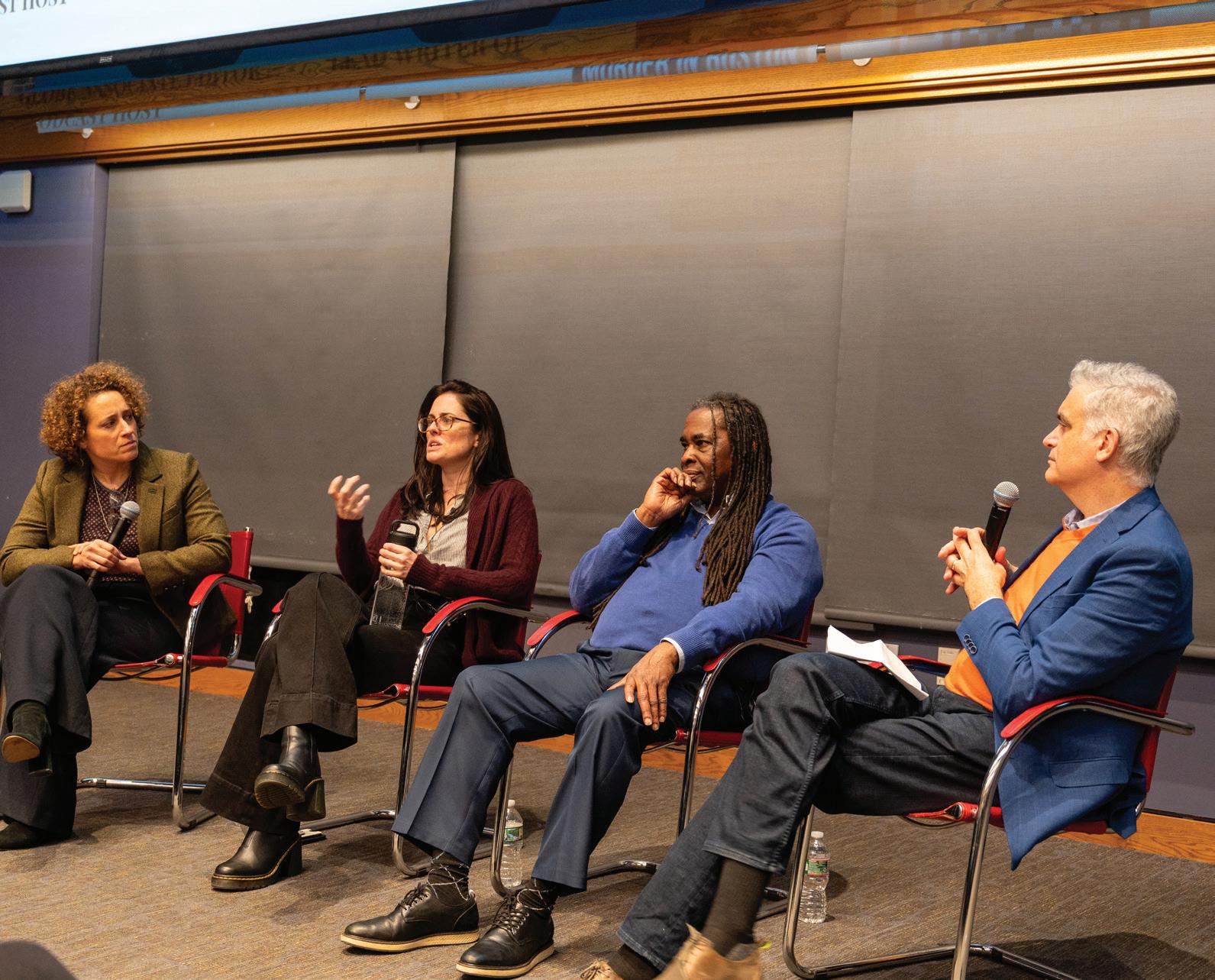
police officer in the initial investigation who believed that he was doing the “right thing.”
As a result of unpacking the story and tracing the investigations at the time, from both police and newspapers like the Boston Globe, Allen stated that people are more skeptical of official sources. This project has left waves in the journalism world and has also left a lasting impression on the reporters of the event themselves. “Going back to my column has been more challenging than before, probably because the project is still taking a lot of space in my head,” Walker said.
“All the things I’m proudest of in my career have messed me up the most,” Allen added. “It takes a certain level of obsession to do these big projects and that’s what stays with you.”
Still, space constraints and the need for an audience posed limits and structure to a story that could have been told in more words and detail. To the two lead journalists on “Murder in Boston,” there are still questions that linger on the lasting implications of the murders, from whether the truth could be so overshadowed by a misdirected investigation to what Mission Hill could have been if the initial investigation was different.
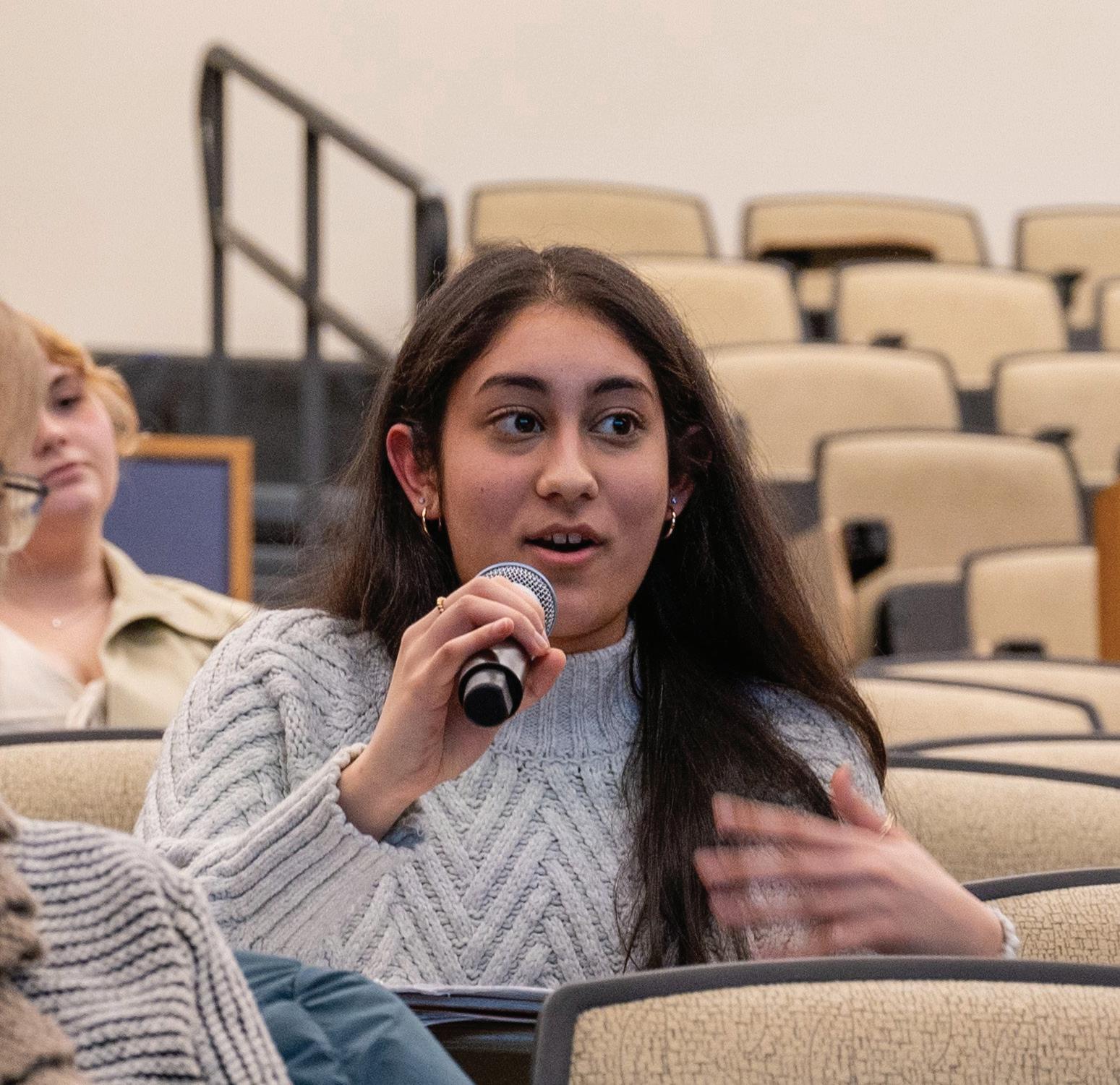

prompt asked those submitting to share their experience “mourning the deaths of tens of thousands of Palestinians and grieving the destruction of the Palestinian people since October 7th and beforehand.” The final product included said contributions pasted over a painting that included pastings of a dove, flags, variations of the Palestinian flag and an image of the Qubbat al-Sakhra, or the Dome of the Rock, an Islamic shrine that sits in the heart of the Al-Asqa mosque in the Old City of Jerusalem. A printed description of the piece laid on the ledge in front of the artwork.
“Brandeis speaks up is a collective art piece, an expression of our community’s earnest pain and grief thorugh the ongoing genocide of the Palestinian people happening in Gaza,” the description read.
Statements were collected from current undergraduate and graduate students as well as other anonymous community members.
“As time goes on, I get more and more scared that this will fall into a backdrop of many other horrors that people feel less compelled to take a personal stand for,” one statement read, while another said it was “gut wrenching” to “have so much visibility into Gaza and also know that this country’s political representatives and many higher ed institutions, including Brandeis admin, are complicit and/ or actively supporting this genocide.” Others struggled “to make sense of the inhumanity we are watching unfold” and felt “horrified and hopeless.”
“Why are we not screaming from the top of our lungs for a ceasefire? For a Free Palestine? We learn about the genocide committed against the Indigenous peoples of Turtle Island on stolen lands. And yet, we do nothing to prevent that from happening again,” one statement read.
Attendees of the vigil were invited to view the display and follow the “calls of action” displayed on a table at the front of the set up. QR codes on small sheets of paper linked to various places accepting donations to aid Palestinians trying to escape Gaza. Text alongside the QR codes asked community members to “Help get innocents out of Gaza” and “Help a 10-month-old Palestinian survive the war,” as well as quotes from Palestinians still in Gaza.
As the vigil began, a student organizer asked attendees to “be respectful.” Since student organizers wished to maintain anonymity, they asked for no one to take recordings of the event or its speakers.
The first speaker touched on the pain they felt in knowing that “our tax money” is funding the Israel-Hamas war. “It feels like there’s very little we can do,” they said.
They were not alone in their helplessness and grief; a graduate student, who spoke next, knew that there was nothing they could say that would truly encapsulate their “cripplingly heartbreaking” grief. “Grief is enraging,” they said, so much so that it was “an amount of anger that if you mustered it, you don’t know if your body could take it.” The graduate student’s anger did not stop there; their voice shook with emotion throughout their speech. They felt “so fucking angry” that they wanted to scream but did not know if they would “be able to stop.”
The speaker said that the “death and destruction” in Gaza has “erased entire families” and caused both mental and physical trauma that
those suffering would “never overcome.” “Do you not see what I see? Do you not know what I know?” they asked, a question hypothetically posed to those who are not upset. “How is it that we’re both human, but only one of us is mourning?”
“If there is solace in something it is that I do not have to carry [this] alone,” they said, recognizing the vigil’s sizable turnout. “I implore you not to look away.”
After the speaker stepped down to applause, a Jewish student led the attendees and organizers in the Mourner’s Kaddish, a traditional Jewish prayer commonly recited to honor the memory of the deceased. The student that led the prayer asked everyone to say the prayer for the Palestinians killed since Oct. 7 and “since 1948.” A moment of silence followed the prayer.
Following the moment of silence, the student organizers invited up anyone who wished to speak or share, and many attendees did. The first student to do so told the crowd that the first and last thing they think about every day is Palestine. Every little thing, such as drinking coffee, causes them to think about the people of Gaza who cannot anymore. However, the student acknowledged that the vigil’s turnout proved “that our communal grief is powerful.”
The student also recited “If I Must Die,” a poem written by Dr. Refaat Alareer. An Israeli airstrike killed Alareer on Dec. 6. The poem was shared online five weeks prior to his death, according to its website. The poem was also written on a piece of cardboard that was part of the vigil’s display with two flowers laid in front of it
Another request was made of onlookers on the balcony to stop recording. “It’s not respectful at all,” an organizer said. The organizer continued to say that they constantly feel “gaslit” by the world around them, which earned a round of applause. There were multiple other requests of the viewers to stop recording or filming throughout the vigil. One of the speakers who did so asked people on the balcony how they “didn’t have morals.” Some of the onlookers were recorded by a member of the RSO.
A subsequent speaker said that if the leaders of both the U.S. and Brandeis believe there is “nothing to grieve, which makes what’s happening far, far worse.” They wondered how said powerful figures see “the murder of children,” “the bombing of hospitals,” and the “starving” of “an entire civilization” and not change their actions. The speaker said that Brandeis is “named after the greatest defender of free speech” on the Supreme Court, but the University uses police to arrest the people it disagrees with. That, they proclaimed, is “unacceptable.” As a Supreme Court Justice, Brandeis is quoted to have said “that repression breeds hate; that hate menaces stable government; that the path of safety lies in the opportunity to discuss freely supposed grievances and proposed remedies; and that the fitting remedy for evil counsels is good ones.”
Free speech was a worrisome topic for others as well. One student said they were tired of the University claiming that it values free speech because they “silence anyone in support of Palestine.” They felt as though their voice was being stolen from them “no matter what” they did.
“Fuck Brandeis! It’s as simple as that,” one
student proclaimed. One common thread throughout many of the speakers was the idea of boycotting. Both boycotting corporations that support Israel such as Starbucks and the University itself were suggested. A later speaker cited the fact that Starbucks has lost a large amount of money as a result of the boycotts. The Economic Times reported on Dec. 7 that Starbucks had lost $11 billion dollars — a 9.4% decline — a loss that is linked to the boycott in response to their support of Israel.
A speaker reminded the crowd that an institution cannot run without money, but that the University is funded by a “very powerful antiPalestinian lobby determining everything happening at this school.” One student called on attendees to boycott the name of Brandeis itself. They are embarrassed to have that name on their resume, as they do not want people to think they are a “supporter of genocide.”
A later speaker called on the community to “ruin the reputation” of the University to prevent more people from attending. “This school will continue to support genocide as long as it is profitable,” they said.
Many of the participants expressed their disappointment in and dismay at the University’s actions. One said that they chose to attend Brandeis because they had believed it was a “social justice school,” but much of its money is going to Israel and “supporting genocide and the death[s] of so many people.” It felt to them like a “spit in the face.”
A Jewish student claimed that it is a “lie” to say that Zionism simply means “self-determination for Jews.” The Anti-Defamation League defines Zionism as “the movement for the selfdetermination and statehood for the Jewish people in their ancestral homeland, the land of Israel.”
The student deemed Theodore Herzl, who was the “visionary of modern Zionism” and the establishment of a Jewish homeland according to the Jewish Virtual Library, a “white supremacist … bastard.” Zionism, they said, supports the “ethnic cleansing of Palestinians,” and that the people of Gaza’s lives were “stolen from them by Zionists.” The student’s voice grew increasingly louder throughout their speech.
Other Jewish students also stepped up to speak. One said that it makes them feel “sick and angry” to hear people say that Israel is the only place Jews could go to if there were another Holocaust. Israel would not want them as a queer Jew, the speaker said, so Joe Biden’s claim that Jews are safer because of Israel is therefore false. “This genocide is not in our name,” they said. “Fuck that country.” Bringing up the Holocaust “over and over again” to “justify a genocide” is the most “horrific fucking thing,” they concluded. A later speech reminded students to use their right to vote. The speaker said they did not want Joe Biden, “an old genocidal fuck” running this country anymore. They disagreed with the “vote blue no matter what” mindset, and advised the crowd to “make wise decisions.” Another student claimed that pressure would cause Joe Biden to send more aid to Gaza or support Israel less.
Two Palestinian students also spoke at the vigil. The first thanked everyone for coming, as it meant a lot to them as a Palestinian at a “Zionist university.” The “apartheid,” occu-
pation and “genocide” must stop, they said; it needed to stop a long time ago. The student also touched on how abnormal it feels to witness the destruction in Gaza. “It’s not living. It’s a concentration camp, the same ones the Jews escaped,” they said, describing how Gazans have to starve, drink sea water or “defecate in the street.” “We brought refuge for [Jewish people],” they continued, “and look what happened.” The student remained calm throughout their speech.
The second Palestinian student reminded listeners that Israel is committing “mass punishment” for Palestinians living in Israel. They said their family and the people they know in Jerusalem and the West Bank cannot find food, and Palestinians are being let go from jobs because of what is happening in Gaza. The Justice could not find a source to confirm this as of press time.
They continued to state that support must be directed to all of Palestine. They felt ashamed to talk about their pain because they are not dying from bombs and their home has not been stolen. The U.S.’ support of Israel distressed them as well; the crowd yelled “Shame!” when the student said that U.S. taxes pay for Israel’s universal healthcare.
Columbia University’s Mailman School of Public Health reports that Israel’s healthcare plan is funded by “an earmarked, income-related tax and general government revenue.”
The student concluded by asking attendees to pray for their family and donate or share GoFundMes for Palestinians.
Another speaker recited the poem “Fuck Your Lecture on Craft, My People Are Dying” by Palestinian-American poet Noor Hindi.
Two faculty members also spoke at the vigil. One expressed their pride in the attendees for “asking the hard questions,” and stressed that they should not let their “grief turn into melancholy.” The other faculty member said they had been at Brandeis for a long time and praised its students for making it a more justice-including place.
More speakers expressed anger at those who don’t “care about what’s happening.” Those people, they claimed, are “disgusting.” The student went on to say that everyone there was privileged to wake up under a roof and to be grateful that they are alive, for “nothing is as uncomfortable as being murdered.” They also criticized passive language: Palestinians “are not starving. They are being starved. They are not casualties. They are being murdered.”
“Face the facts. It did not start on October 7,” they said.
One speaker reminded those at the vigil that their “words have power.” The words “conflict” or “situation” do not appropriately describe the situation in their opinion, and they felt hurt and disgusted when hearing that.
They said, “It’s not a situation. It’s not a fair fight. It’s ethnic cleansing.”
As the vigil came to a close, one of the student organizers notified attendees that two undercover police cars were outside and advised those leaving to be safe and “buddy up.” The Justice could not confirm the police presence as of press time.
SJP and RSO plan to hold a mass meeting at 7:30 p.m. on March 12 in Shiffman 202. They will discuss how they can further their efforts on campus to support Gaza and the Palestinian people.

Western aesthetic ideals of symmetry and balance have influenced much of what is considered the “standard” in the artistic world. Emerged from the domestic sphere, African American women’s quilting traditions challenge these artistic assumptions.By GRACE DOH JUSTICE EDITOR
A childhood activity that many American students completed in school is the coloring of the Thanksgiving turkey. Some students chose to color the feathers in a random fashion, making them each one of their favorite bright colors. Other students colored the feathers in a controlled, pastel gradient. Just like with those turkeys and the various approaches to coloring them — each different but not better or worse than another — there are no set rules that can be applied to any given artistic tradition. With this approach, the viewer shifts their mindset to the landscape of the individual piece and assesses it independently as a unique item, rather than one that needs to be measured against other works, styles or expectations.
According to Black feminist scholar Elsa Barkley Brown, when it comes to quilting and textile making, what the art world has long deemed conventional are the Western values of balance, symmetry and a meticulous coordination between the compositional elements. African American women’s quilting art is more interested in contrast, striking colors and abstract patterns. On this, she says that “The symmetry comes through the diversity.” Brown’s interpretation of “gumbo ya-ya” — a Creole expression that means “everybody talks at once” — embodies the distinct stylistic qualities of African American women’s quilting.
In her essay “African-American Women’s Quilting,” Brown sets out to share her own approach to studying African American women’s art by encouraging conversations to shift away from preconceived notions of what is considered normative — the white, middle-class male experience. The issue that she proposes is not simply a question of being able to intellectualize about a variety of experiences, but rather being able to acknowledge them without seeing them in terms of a certain “standard.” Rather than decentering one experience to center another, Brown proposes “pivoting the center” in the words of political activist Bettina Apthecker. By doing so, we can assess African American women’s art within the context of their own experiences and also be equipped to learn about other cultures’ artworks without relying on a Eurocentric yardstick.
With this idea of “pivoting the center,” Brown introduces an interesting perspective on African American women’s quilts: Gumbo ya-ya is a phrase that originates from the Louisiana Bayou country and has persisted as a key element of Creole custom. The implications of this motto are deeply significant to African American women’s experiences, which are often influenced by democratic community and collectivity. As everybody talks at the same time, the individual has their own voice which is unique but not divorced from the whole. Each individual is simultaneously speaking, contributing, listening and responding, and not one person dominates nor does
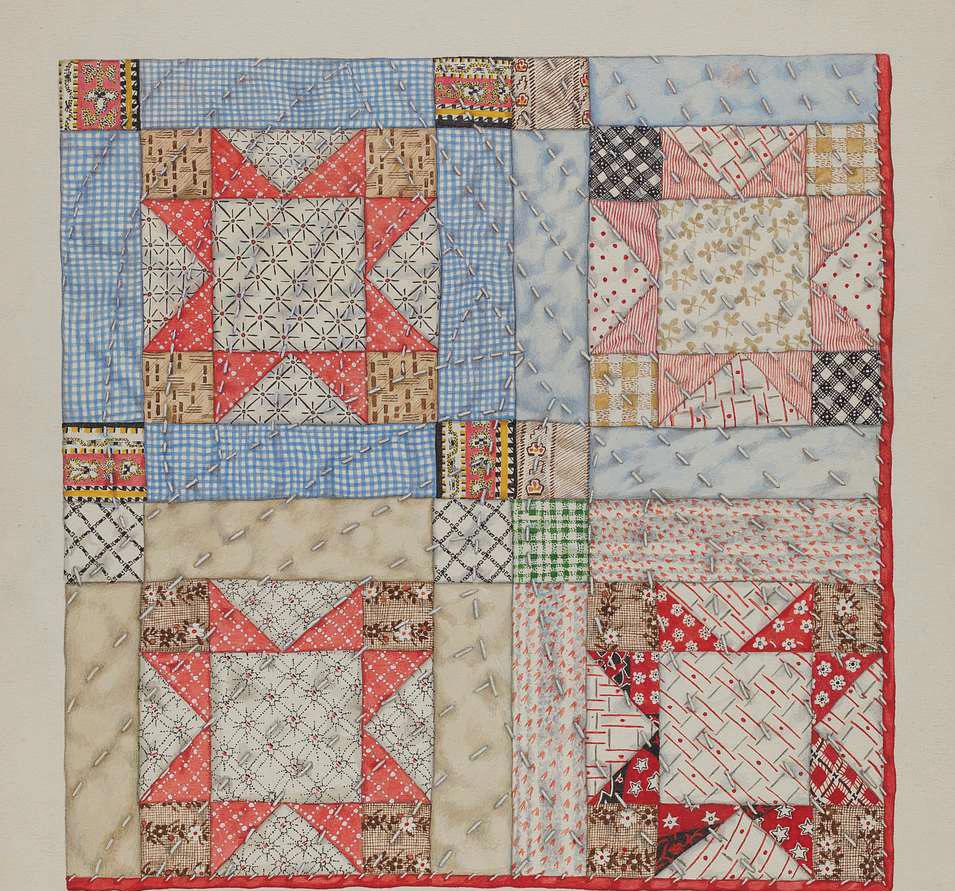
the whole attempt to achieve an “objective” consensus.
Citing “Aesthetic Principles of Afro-American Quilts” by Maude Southwell Wahlman and John Scully, Brown refers to the polyrhythms of improvisational jazz as a guidepost for viewing quiltwork in terms of gumbo ya-ya. Wahlman and Scully write: “When the colors of the strips are different from the colors in the row of blocks or designs, two distinct movements can be seen: one along the strips and the other within the designs … This represents a textile aesthetic which has been passed down for generations among Afro-American women who were descendants of Africans … Afro-American quilters do not seem interested in a uniform color scheme. They use several methods of playing with colors to create unpredictability and movement.”
Historian Lawrence W. Levine describes this style: “The various voices in a piece of music may go their own ways but still be held together by their relationship to each other.” Essentially, no one part of the ensemble needs to be quiet in order for another to be heard; each player in the piece can be vocal and prominent in a way that does not detract from the contribution of other players. When looking at African American quilts with this frame of mind, viewers are confronted with the questions of “does good composition necessitate certain shapes or colors to submit to others in order for there to exist a harmony among them?” and “does the visual story being told need to convey a single consensus?” Aptheker’s idea of “pivoting the center” comes into play when considering these questions about African American women’s history and their non-Western philosophies of self-expression and communication.
One of the most notable sources of African American women’s quilts is the Gee’s Bend community located in Boykin, Alabama, which produced a prolific collection of aesthetically distinct quilts. The African American agriculture-based community in Gee’s Bend consisted of descendants of the enslaved people who worked on Joseph Gee’s cotton plantation in 1816. The Gee’s Bend women’s quilt-making practice was born of necessity, but in their creative process these women assumed a sense of ownership of their living space by repurposing textiles into colorful and meaningful displays.
In this rural farming region, women’s time and labor could usually only afford to serve utilitarian purposes, leaving few expressive mediums of creation, many of which were within the realm of domestic use and craftsmanship. Possessions were there for practical use, such as the quilt, which traditionally served to keep families warm at night. It was through domestic tasks that women managed to create art ,as it was accessible to them at the time.
In addition to the agency that quilt makers found in utilizing creative expression and personalizing their living space, they also found comfort in the meditative nature of stitching, especially with the help of other women. Gee’s Bend resident Missouri Pettway found solace in stitching and strip-piercing her late husband’s clothes into a quilt to keep his memory alive. Her daughter, Alonzia Pettway recalls helping her tear up the strips of cloth. In her book, “Stitching Love and Loss: A Gee’s Bend Quilt,” Vassar College Professor Lisa Gail Collins writes, “When Missouri Pettway created her quilt, it was common local practice for female kin and other neighborly women to visit a quilt maker’s home and assist in the final step of sewing together, or quilting, the layers of her quilt.” Through kinship and community, the gumbo ya-ya principle manifested in the work-up of these Gee’s Bend quilts, as different parts of the blanket were sewn together by different women.
While quilt making has a rich history originating from the enslaved women of Gee’s Bend and that history often informs study of African American women’s quilts, it is worth noting that the practice has been inherited through generations and has since been adapted by numerous contemporary artists. Modern quilts can be interpreted
TOMPKINS: Quilt-maker Rosie Lee Tompkins was known for her eclectic, assymetrical designs.
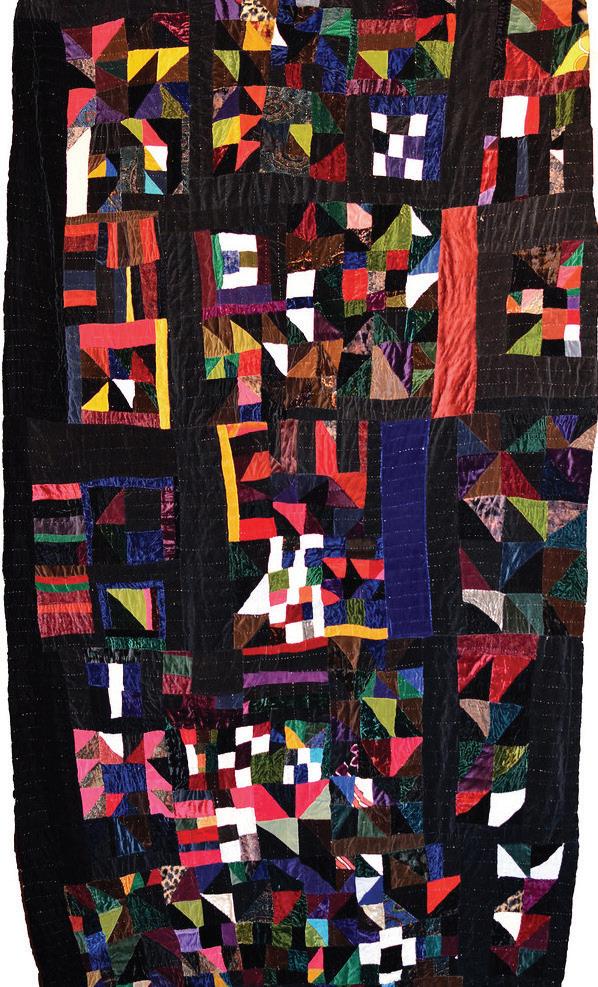
in countless ways, showcasing all aspects of the creator’s internal life from symbols of kinship to religious iconography to their perspective on the cultural world. In the late 20th century, quiltmakers Rosie Lee Tompkins and Maxine Wallace of W Magazine wrote: “…she shifts between Mondrian-esque blocking to more traditional patchwork, then takes a hard left turn with an abstract, fractal quilt bearing religious overtones, crosses akimbo. Then, she’ll suddenly switch to what can only be described as pop art: images of Michael Jordan, OJ Simpson, John F. Kennedy, and even Jesus Christ appear in various compositions. Her use of text, stitched into the fabric, resembles Basquiat’s scrawl.”
Tompkins’ quilts engaged with pop culture and her interests were situated in the modern world, but she also preserved the gumbo ya-ya nature of her predecessors’ quilts as seen in the maximalism and bold juxtaposition in her individual pieces as well as her experimentation with such a broad range of styles. For Tompkins, one individual piece or element of a piece is not at odds with the collection to which it belongs.
The exploration of quilting traditions, from the Gee’s Bend community to contemporary artists like Rosie Lee Tompkins, demonstrates how African American women’s art is uniquely rooted in a communal, democratic experience. The Gee’s Bend quilting tradition, shaped by collaboration, speaks to the way women found solace, meaning and purpose in this artform. The legacy of Gee’s Bend has been inherited by modern artists like Tompkins, whose eclectic and experimental approach also embraces the gumbo ya-ya ethos. Through the rich tapestry of African American women’s quilting, we find not only a unique artform pioneered by women from the domestic sphere, but also a testament to the compelling works that come from abundance and allowing room for multiple voices to exist at once.
There are many social factors that dictate and guide health, some of the most prominent being race and gender. Examples include unethical medical testing on Black women in relation to reproductive health, the Tuskegee Syphilis experiment, race-based correctional factors in vaginal birth after cesarean tests, the prescription of BiDil and socioeconomic factors influenced by race and gender.
The U.S. has a long history of racial bias and profiling in medicine, which continue to plague the healthcare system today. This phenomenon perpetuates the idea of inherent biological disparities among races within the medical profession.
Looking back in history, many people of color, especially Black women, have been subjected to unethical medical experiments due to racial profiling. For instance, experiments conducted on enslaved women concerning cesarean sections and obstetric fistula repair took place without consent or any pain medication as a result of the misconception in the medical field that Black women had a higher pain tolerance than white individuals; this notion still continues in contemporary medicine.
As a result of experimentations related to C-sections and obstetric fistula, the obstetrics field advanced dramatically. Therefore, America must be cognizant of the racial and gender bias that allowed for medical advancement. There are countless ways that this racial and gender bias impacts medicine today, thus demonstrating that the medical field continues to use and abuse people of color.
More modern examples of racial profiling include the vaginal birth after cesarean race-based filters, the Tuskegee Syphilis experiment and the prescription of BiDil to primarily Black patients. All of the examples and experiments listed above were created based on an individual’s race rather than on biological facts.
In a 2014 study concerning structural racism 26.2% of all Black, non-Hispanic individuals were found to be living in poverty and 38% of Black, nonHispanic children younger than 18 were living in poverty. When this epidemiologic data is combined with racial profiling in contemporary medicine, the idea of health improving as one’s social position rises — otherwise known as the social gradient of health — emerges, supporting the idea that health is impacted by social factors. By examining health outcomes and inequalities through the lens of interactions between race and gender, the concept of the social gradient of health and the theoretical framework of the social
determinants of health become evident on a broader scale. This view can be carried out by looking at modern examples of case studies that exemplify the social gradient of health and support the social determinants of health. Through the analysis of case studies, viable solutions and policy reforms emerge as potential avenues to address and mitigate health inequalities. The theoretical framework of the social determinants of health posits that social factors play a significant role in indi-
By ELIZA BIER JUSTICE EDITORcurrency. The social gradient of health lends itself to be used as a measurement tool for the social determinants of health.
Specifically, as it concerns race and class, the combined effect of social factors and improving social position underscores race and gender as pivotal determinants of health outcomes.
As discussed above, gender and race intersect, causing health inequalities. One example is the use of race-based modifiers in VBAC tests. VBAC is a series of questions that decides the likelihood of a pro-
vises based on race and what shape pelvis is better suited to delivering vaginally. The use of a race-based correction factor in VBAC scores, when examined through the theory of social determinants of health, shows that one’s gender and race can be used as social capital, which directly affects health care inequalities and outcomes.
Furthermore, disparities in women’s cardiovascular outcomes compared to men’s is another indicator of the way that gender affects healthcare treatment. The symptoms of CVD in

viduals health outcomes. Lack of access to healthcare, whether due to monetary issues or accessibility challenges getting to a doctor, can heavily impact an individual’s health — not to mention what type of healthcare individuals have access to. There are socioeconomic differences in the type of healthcare available to areas with different incomes.
Typically, access to quality healthcare is correlated with disposable income. Lower-income areas, if they have access to healthcare, can only access healthcare services such as free clinics and teaching hospitals.
The social gradient of health implies that race and gender have a substantial impact on this idea in the form of social
spective parent delivering a baby vaginally after previously delivering baby via C-section. As a part of the battery of questions asked, race is taken into consideration, and if the prospective parent is either Black or Hispanic, according to the results of the VBAC test, their likelihood of successfully delivering a baby vaginally after a Csection decreases significantly.
In one instance there was a 15% increase in the likelihood of vaginal birth after a C-section solely based on whether the patient identified themselves a white rather than as black or Hispanic. The reasoning behind such a large VBAC difference is racial profiling, specifically, judgements made about the shape of biological female’s pel-
women are under researched, which contributes to the disparities in outcomes. Not only does the lack of research and diagnosis of CVD in women contribute to some of the health disparities in women’s CVD, but it also exposes a failure in the medical system that can be applied to a wide range of women’s health care outcomes beyond treatment of CVD.
Many women consistently avoid seeking medical treatment until absolutely necessary, because there are many cases in which male doctors give women biased care and do not listen to women’s concerns. This leads to worse health outcomes. However, when women are treated by female doctors and given less biased, patient-
centered care their health outcome improves. Due to lack of research and the fact that CVD symptoms in women often look different than in men, doctors often misdiagnose women who have CVD, which ultimately leads to more drastic and often fatal health outcomes.
Another example of the intersection of gender and race in the healthcare field is the heart failure drug, BiDil. BiDil was approved in 2005 by the FDA despite significant problems with its scientific evidence. BiDil is prescribed predominantly to Black patients as it is thought to work effectively for Black patients over white patients. However, in the original study examining the effectiveness of BiDil for heart failure, only Black men and women were used as test subjects, thus skewing the data.
Since the original study, more studies have been conducted disproving this notion, but many doctors still prescribe BiDil to Black patients for heart failure, even when it might not be the most effective drug to treat their condition. With the disparities in healthcare outcomes for women with CVD and the racial bias in prescribing BiDil to Black patients, it becomes clear that Black women are most at risk to experience drastic and possibly fatal health outcomes due to gendered and racialized healthcare in America.
Access to health care needs to be increased in order to reduce health inequalities. Patients would greatly benefit from the medical profession providing more patient centered care, rather than generalizing symptoms and diagnoses, which shows bias against Black women, thus adversely affecting their health outcomes. To improve the care for women in particular, more research needs to be done to update how conditions and diseases affect females and not just men. These policy solutions will help to fix the issues in the case studies described above, help to narrow the healthcare inequalities and supply more resources to focus on other areas described in the social determinants of health.
Anna Martin, Lauryn Williams, Deputy Editors
Owen Chan, Zachary Goldstein, Julia Hardy
Mina Rowland, Associate Editors
Sophia De Lisi, Anika Jain, News Editors
Grace Doh, Features Editor
Rani Balakrishna, Sports Editor
Nemma Kalra, Arts & Culture Editor
Eliza Bier, Ceci Xilei Chen, Photography Editors
Sara Samuel, Madison Sirois, Copy Editors
Marina Rosenthal, Layout Editor
Elizabeth Liu, Ads Editor
Amanda Chen, Eden Osiason, Online Editors
When searching for the perfect school, campus tours are an irreplaceable resource. But what happens when the information given on these tours is false?
If you have walked around campus and spotted a tour outside the Usdan Student Center, you have probably heard boasts about the Waltham and Boston/Cambridge shuttle services. While guides often praise the shuttle’s reliability, this is not the experience of most Brandeis students.
After the switch from Joseph’s transportation to DPV Transportation, students hoped that the new Waltham and Boston/Cambridge shuttle would be more reliable. Though the drivers for the campus shuttle have been praised for their kindness and punctuality, this is not the case when we look outside the Brandeis campus.
Despite removing driving the BranVan as a job for students due to a lack of consistency, the new shuttle service has been the same in terms of dependability on the Waltham and Cambridge/Boston routes. With the implementation of the TripShot application, students are able to track the shuttle and plan routes, seemingly solving many issues that existed prior to the new company. However, students are often faced with notifications of issues with the tracking or transportation services.
Furthermore, Brandeis claims to provide its students with “safe and efficient transportation.” However, many members of this editorial board have been left stranded in the greater Waltham area due to shuttles failing to show up.
Not only is this inefficient, but it is extremely dangerous. In theory, the Boston/ Cambridge shuttle is scheduled to run until
1:45 a.m. from Friday and Saturday to Sunday. However, in practice, this shuttle is rarely seen running at this hour. This means that young adults are often forced to take an expensive ride from a stranger via Uber or Lyft quite a far distance rather than the “safe” shuttle option advertised by their school.
This concern for student safety has been compounded by the University’s stances on current events, which have placed a greater target on Brandeis students.
The risks described in Matthew Rushton’s March 9 email warning students about an individual harassing students walking on and near campus shed even more light on the need for safe, reliable transportation options for students.
With this being said, it is important to note that safety on the Waltham and Boston/ Cambridge shuttles themselves is also a concern. There is no policy requiring IDs to be checked, so anyone can walk onto the shuttle. This could potentially put the students and drivers alike at risk.
When it was announced that Brandeis would be hiring a new transportation manager, there were hopes that many of the issues stated above would be resolved. Nevertheless, this new manager has not completed any substantial work up until this point and students are beginning to become restless. As a board, we encourage students to submit feedback through Tripshot.
We understand sporadic issues, but leaving students stranded and unable to return to their homes on campus is an unacceptable outcome. By creating a direct line of communication between students, drivers and the administration, hopefully, we can resolve some of these problems.

For many students at Brandeis University, securing employment on campus is not just a matter of earning extra spending money or gaining valuable work experience. It’s a necessity, a means to help offset the ever-rising costs of higher education and to make ends meet. However, for those without the coveted Work-Study aid, the path to employment is often fraught with obstacles, frustrations and a concerning lack of transparency and equity. This editorial aims to dissect these issues, emphasizing the need for equitable employment opportunities and recognition of student contributions to the University’s branding and operations.
At the heart of the matter is the observation that student jobs, crucial to the marketing and daily operations of Brandeis, are often advertised as available yet remain elusive for many who apply. The lack of transparency and communication — where applicants are left in the dark about the status of their applications — does not just signify operational inefficiency; it highlights a disconcerting disregard for students’ time and financial needs. The reality that this issue is not exclusive to those without Work Study but also affects those within the program adds another layer of concern. Students, irrespective of their financial aid status, encounter similar obstacles, pointing to a systemic issue that transcends individual circumstances.
The University’s treatment of its student workforce can be perceived as dismissive, given the long waits for job confirmations and the curtailing of work hours. It is common for first-years to take two and a half months or more to get their first job offer. Furthermore, the restriction to a 10-20 hour work week, forces some students to juggle multiple jobs to make ends meet, reflecting a failure to recognize the economic realities facing college students. Certain members on the editorial board, despite holding two jobs, cannot fulfill the Financial Aid Office’s projected budget, underscoring the disconnect between the University’s policies and the financial pressures students face.
In a move that has significantly impacted student employment opportunities, Brandeis has made notable changes to its operational structure, including the alteration of its shuttle service provider. This decision has led to a comprehensive overhaul of the shuttle system, resulting in an unexpected dismissal of students employed as BranVan drivers. These students, who once navigated both campus and Waltham routes, suddenly
found themselves out of work due to the administrative shift. Compounding the issue, the University has also phased out other student positions, such as those for COVID-19 testing assistants, which further narrows the already limited job prospects for the student body. While the introduction of new roles offers some solace, the number of positions available is minimal. This addition does little to offset the loss of the previously available roles, leaving a significant gap in the employment options for students on campus.
To offer more open positions to students, this board urges the University to consider student leadership positions in secured clubs to be paid. The Student Leader Prize Policy, originally established in 2021 to address barriers to involvement in student leadership roles, aims to award student’s involvement and leadership on campus. BEMCo, Campus Activity Board, SSIS, Student Union and Waltham Group are provided prizes annually. In the Community Advisor Program, Community Advisors work with our on-campus student population in all of our residence halls and wear many “hats,” such as community builder, residential educator and programmer, community standards educator, peer advisor and team player within Community Living. Although they work hard to provide us a safe and comfortable community to live in, they do not get paid. According to the program page, they receive $1,500 meal swipe compensation and a guaranteed single room on-campus. This board believes that CAs should be paid as a student job since this compensation is highly inflexible and doesn’t match with the effort they contribute to the community.
In the end, the issue of student employment without Work Study is not merely a matter of dollars and cents. It is a reflection of Brandeis’ values and its commitment to upholding the principles of equity, opportunity and respect for the countless contributions made by its students.
By addressing the systemic issues plaguing the current employment landscape, Brandeis can pave the way for a brighter future — one where every student’s efforts are valued and their potential is nurtured, regardless of their financial circumstances.
— Editor’s Note: Lin Lin Hutchinson is a Community Advisor and did not contribute to the article

The Oscars, with their glamorous red carpets and golden statuettes, serve as pinnacle of recognition in U.S. cinema. Yet, they are much more than a mere ceremony; they symbolize a cultural moment and a snapshot of the narratives that captivate audiences and capture the imagination of the industry.
They are a reflection of the ever-evolving landscape of filmmaking, where stories become vessels for societal commentary and artistic expression. In the case of Martin Scorsese’s magnum opus, “Killers of the Flower Moon,” its journey from Osage County to the stage of the Academy Awards mirrors a broader narrative of Indigenous representation in Hollywood.
Filmed against the backdrop of Osage County in 2021, “Killers of the Flower Moon” was a cinematic odyssey that delved into a dark and often overlooked chapter of American history. Set in the 1920s during the infamous “Reign of Terror,” the film chronicled the brutal murders of Osage Nation citizens by white individuals seeking to plunder their oil. It was a narrative that resonated not only for its historical significance but also for its timely exploration of systemic injustice and the resilience of Indigenous communities.
Despite critical acclaim and anticipation, “Killers of the Flower Moon” found itself in fierce competition at the 96th Academy Awards, particularly against Christopher Nolan’s “Oppenheimer,” which swept the awards with seven wins, including Best Picture.
However, it was Emma Stone’s unexpected victory over
Lily Gladstone in the Best Actress category that underscored the challenges faced by Indigenous representation in Hollywood.
Lily Gladstone’s portrayal in “Killers of the Flower Moon” was nothing short of groundbreaking. As an Indigenous actress, her performance captured the nuances of her character with authenticity and depth, shining a spotlight on the talent and storytelling prowess within Indigenous communities.
Yet her loss to Stone, while undoubtedly a testament to Stone’s own talent, highlights the persistent struggle for recognition and visibility faced by Indigenous artists in mainstream cinema and representation in Hollywood.
Prior to the Oscars event, there was widespread anticipation and excitement surrounding the potential victory of Gladstone.
Having already secured accolades such as a Screen Actors Guild award and a Golden Globe, Gladstone was poised to make history as the first Native American to win an Oscar in the ceremony’s nearly century-long history.
In her acceptance speech at the Golden Globe awards in January, Gladstone dedicated her win to “every little rez kid, every little urban kid, every little Native kid out there who has a dream.”
Throughout the extensive history of the Academy Awards, a glaring absence looms: the lack of recognition for Indigenous North American talent in the competitive acting categories.
To date, no Indigenous individual has secured a competitive Oscar for acting, underscoring a longstanding disparity in Hollywood’s acknowledgment of diverse narratives.
Gladstone is only one of the five Indigenous performers in
the history of the Academy Awards who have been honored with a nomination or an honorary award.
The significance of Indigenous representation extends far beyond awards ceremonies and red carpets. It’s about the power of storytelling to shape perceptions, challenge stereotypes, and reclaim narratives that have long been marginalized or silenced.
In the case of “Killers of the Flower Moon,” the film served as a platform to amplify the voices of the Osage Nation and shed light on a colonial history that had been buried beneath layers of erasure and neglect.
However, the film’s journey to the Oscars also laid bare the systemic barriers that continue to hinder Indigenous representation in the industry.
From limited opportunities for Indigenous actors and filmmakers to the perpetuation of harmful stereotypes and whitewashing, the road to equitable representation remains fraught with challenges.
The success of “Oppenheimer” at the Oscars, while undoubtedly deserving, further underscores the need for a more inclusive and diverse landscape in Hollywood.
It’s not enough to simply tell stories; we must also ensure that those stories are told authentically and responsibly with the participation and input of the communities they represent.
As we reflect on the 96th Academy Awards and the legacy of “Killers of the Flower Moon,” let us not only celebrate the achievements of those who were recognized but also double our efforts to amplify Indigenous voices and stories in cinema. Only then can we truly honor the richness and diversity of our shared human experience.
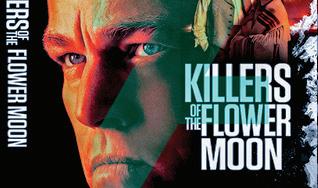

■ The power forward, in his second decade in the NBA, has cemented his mark in the league with 40,000 points.
By BENJAMIN VIDAL CALDERON JUSTICE STAFF WRITERLeBron James, a living basketball legend, added another remarkable chapter to his illustrious career last Saturday at Crypto.com Arena. The Los Angeles Lakers star achieved an unprecedented milestone by becoming the first NBA player to reach 40,000 career points. The accomplishment took place during the Lakers’ game against the Denver Nuggets, a special night to honor James and fans in attendance around the world.
Entering the game just nine points short of the 40,000-point mark, James surpassed this feat early in the second quarter with a spinning left-handed layup past Nuggets forward Michael Porter Jr. With 10:39 left in the quarter, James had the crowd on their feet, erupting in cheers as the arena witnessed history in the making and as he cemented his status as the league's greatest scorer. Lakers coach Darvin Ham congratulated James with a pat on the chest, and an in-arena video presentation followed, capturing the essence of this extraordinary achievement.
LeBron James finished the night with a teamhigh of 26 points, showcasing his enduring skill and impact on the court. Despite the record-breaking sensation, the Lakers ultimately fell to the Denver Nuggets with a final score of 124-114. James showcased his competitive spirit expressing disappointment that this historic moment occurred in a defeat.
In an interview after the game, James expressed his mixed emotions about the milestone, describing it as “bittersweet.” He highlighted the significance of being the first player to achieve such a feat in a league with a rich history of legendary players. “Being the first player to do something, it's pretty cool in this league, just knowing the history, the greats that have come through the league,” said James.
This achievement adds yet another layer to LeBron James' already remarkable career. At the time of publication, James has over 1,478 regular-season games in which he has consistently scored double-
digit points, reminding viewers of his scoring prowess and status in the league as king. James’ dedication to excellence is further emphasized by his ability to maintain such a high-level performance for over two decades.
Reflecting on the intense pressure he has faced since entering the league as an 18-year-old, James shared his thoughts on the expectations placed on him. He recalled a commercial that mentioned him as “the next one” after legends like Oscar Robertson, Michael Jordan, Kareem Abdul-Jabbar and Kobe Bryant. James expressed the surreal nature of such expectations on a young player and how he has navigated the challenges throughout his career.
Notably, LeBron James is not just a regularseason scoring sensation; he also holds the title of the NBA's all-time playoff scoring leader with 8,023 points, surpassing the legendary Michael Jordan. That said, James is not only a prolific scorer but also an exceptional playmaker. Currently ranked fourth in career assists with 10,847 and an average of 7.35 per game, he continues to contribute to his team's success in multiple facets of the game. Not to mention, being eighth all-time in steals showcases his versatility and impact on the game. In February, he surpassed Kareem Abdul-Jabbar's previous record of 38,387 career points, a testament to his consistent greatness.
James acknowledged the skepticism surrounding the possibility of breaking records when he started his career. He mentioned that people believed Kareem's record would never be broken, but James has defied those expectations. He attributed his success to a combination of skill, longevity, and good fortune, emphasizing the importance of maintaining a high level of play for an extended period.
Looking ahead, LeBron James’ 40,000 career points record seems insurmountable for the current generation of players. The closest active player, Kevin Durant, has accumulated 28,372 regular-season points, making James’ record appear secure for the foreseeable future. With his exceptional durability, postseason success and avoidance of major injuries, James has solidified his place as one of the greatest players in NBA history.
With James under contract through the 2024-25 season, the 40,000-point mark remains a moving target, solidifying his legacy as one of the greatest players in NBA history. As the basketball world continues to marvel at LeBron James' achievements, one can't help but wonder what other historic milestones he will achieve before the final buzzer of his notable career.



■ Following Mondo’s latest win at the Indoor World Championships and his history as a pole vaulter.
By SMILEY HUYNH JUSTICE MANAGING EDITORArmand “Mondo” Duplantis won the 2024 World Athletics Indoor Championships with a world-leading jump of 6.05 meters, marking his fourth consecutive world championship gold medal. Due to all of his achievements, it is worth asking if Mondo can now claim the title of pole vault greatest of all time.
Coming from a family of athletes, Mondo was always set up for success, and destined for the world stage. Between having a former professional pole vaulter father who jumped 5.80 meters and is now his pole vault coach, to a former Swedish heptathlete and nutritionist mother who is now his main trainer, athletics are in his blood. He also had a pole vault pit in his backyard that he has been jumping at since he was three. Destined for the world stage, he started small in setting records starting at the age of seven, breaking every age group record until he was 14 He then set the age world records from 16 to 19 — which is when World Athletics stops officially counting. They restart counting for Master’s at the age of 35. However, Mondo likely has the age group records up to his current age of 24. His most notable record in 2017 was when he set a World Junior Record multiple times. In 2018, while still in high school, he proceeded to compete
at the professional level with his childhood hero Renaud Lavillenie — then, the world record holder — as well as joining the 6-meter club, an elite group of male vaulters that have jumped over six meters. As of now there are only 28 men that have vaulted over six meters. His vault of 6.05 meters at the European Athletic Championships ranked him as the fifth-best pole vaulter in history at just 18 years old. In 2019, he got silver at the world championships.
In the short period of 2020, before the shutdown of all professional athletic competitions, he set high expectations — typical in the Summer Olympic years. In the first week of February, Mondo set a world lead by clearing six meters. Four days later on Feb. 8, he proceeded to break Lavillenie’s six-year-old world record when he cleared 6.17 meters and then just seven days later, proceeded to set another world record on Feb. 15, when he cleared 6.18 meters. This is extremely impressive considering the record that Lavillenie broke had stood for twenty years and was jumped by the pole vault legend Sergey Bubka. The revolutionary of the sport, Bubka, was the first to break the six-meter barrier and 20-feet barrier and took the world record in 1984 at 5.85 meters, skyrocketing it until 1994, leaving it at 6.14 meters. His style of pole vault was so good and different that a now common drill for pole vaulters, Bubkas, is named after him.
Bubka was not only dominant in setting world records as he broke the world record 35 times — the indoor record 18 times, and the outdoor record 17 times — but also at the all-important world championships in which he won six consecutive world championships (however this was when World Athletics was still named the International Amateur Athletic Federation and only held world championships every three years). However, he
only won one gold medal as he represented the Union of Soviet Socialist Republics for much of his career. This meant that he had to follow the 1984 Olympics boycott as they were held in Los Angeles, California. In 1988, he won his first, and only, Olympic gold medal and in the subsequent three Olympics, he alternated between failing to clear his opening height and suffering an unfortunate heel injury. When he represented the USSR, he was rewarded monetarily for breaking the world record each time. This compensation continued after the dissolution of the USSR when he began to represent Ukraine because he signed a deal with Nike who gave him a $40,000 bonus every time he broke the world record. This brought out the spectacle in pole vault as he would break the world record by centimeters to maximize the reward. This tradition is continued by Mondo, as every time he breaks the world record he retires from competition, saving the next world record breaking jump for another competition.
Given Bubka’s monumental career, it is difficult to consider Mondo the all-around greatest pole vaulter of all time because while Mondo has broken the world record seven times, this number pales in comparison to Bubka’s 35 times. That being said, Mondo is well on his way to becoming the GOAT of pole vault as he has cleared over six meters more times in competition than Bubka, and as of February 2023, he accomplished this more than 60 times*. He also has won the World Championships — including indoor and outdoor — four consecutive times, though this has given him way more opportunities than Bubka had. He has also matched Bubka in the number of Olympic medals, having won the 2020 Tokyo Olympics.
Mondo has also won three consecutive Diamond Leagues, which are competitions unavail-
able to Bubka and only available at the tail end of his career, the equivalent being the IAAF Golden League. He is the reigning champion for the Diamond League, Indoor and Outdoor Championships, and the Olympics, as well as many other prestigious championships such as the European Indoor and Outdoor Championships. Mondo receives nothing but gold.
Additionally, Mondo is an indomitable competitor, which has been said in some way or another by every pole vault competitor and commentator commenting on Mondo — they joke that every competitor is fighting for second place. This includes the silver medalist at the Tokyo Olympics, Chris Nilen, who said that Mondo’s superiority over the other professional pole vaulters was “impressive and ridiculous.”
Mondo is a talent that is one in a generation and we are all lucky to have seen and continue to see history in the making. He is only at the beginning of his career. seeing as Bubka retired at the age of 38 and Lavillenie, aged 37 — the only other jumper to have jumped higher than Bubka — has yet to retire. Mondo is just 24, we are bound to see him compete for a long time, even if he is not the pole vault GOAT… yet.
*The number of times that Mondo has cleared six meters and up in competition is at least 71, considering he’s won 11 competitions since the 60 number was reported when he broke the world record for the fifth time, however it is likely higher but can not be verified by the writer because World Athletic does not release the field series reporting all the heights jumped in competition, only the results.
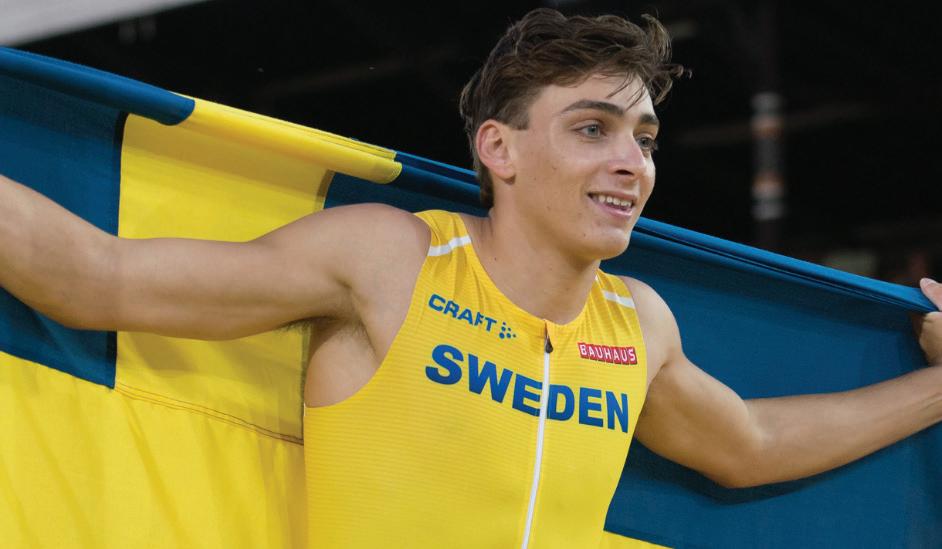
CONTINUED FROM 16 out hot, coming in their first laps at a very aggressive low to mid 26 with Carleo in fourth in the heat with a high 26. In the two laps after he kept a strong but slower pace in the 28’s but in his final lap the effect of the competitive first lap paid its toll taking 31.03. He finished with his slowest time this season — accounting for the banked track — at 1:54.33. Despite this, Carleo remains positive about his season saying, “the season as a whole was a good one. It had ups and downs throughout but I was really happy with the progression I made. It’s a bummer to end it with not my best race at nationals but that’s the sport. At this time last year, even going to nationals was still a dream.” This sentiment is echoed by Carleo’s primary coach, Michael Schmidt, who was very positive about his overall season, saying, “TJ followed up a strong cross country season with an even better indoors — his energy and focus was well channeled to the team from start to finish. He is an exceptional racer and topped his [indoor personal record] from last indoor season five times.”
While the nationals meet marks the end of his second indoor season, he still has an outdoor sea-
son to try again, with a two week break before the teams first outdoor meet at the Tufts Snowflake Invitational. He will have time to recover and come back better, especially considering the bigger track may help his racing strategy. The outdoor season added on top of the fact that he has two additional years means we aren’t even halfway through Carleo’s collegiate running career. Carleo says, “looking forward, my goal is to qualify for the NCAA Division III Outdoor Championships” and that he is “also excited to build up [his] mileage and training for the upcoming season.” His coach said, “He gained some valuable experience racing at NCAAs and is well prepared to take his successes of all his all-UAA and NCAAqualifying [indoor] season to a fantastic outdoor track and field [season].” Hopefully we’ll see Carleo’s exceptional racing during the outdoor season and watch him punch another ticket for nationals!
Rebecca Suarez ’26, women's tennis
For the first time in Suarez’s career, she earned a UAA Athlete of the Week Honor for the week of Feb. 11. She earned this honor in the first
match of the season against the then-ranked 10th Massachusetts Institute of Technology, winning her doubles match with Bhakti Parwani ’25 8-2 and winning her singles match in three sets 4-6, 6-4, 6-2. She then went on to win another match against the then-ranked 22nd University of Redlands with her doubles partner Parwani with a score of 8-4, though the team overall lost 7-2. They went on to win more doubles matches against the then-ranked 21st California Institute of Technology, 8-4, and repeated their win against the ranked first Claremont-Mudd-Scripps College 6-2.
Haley Nash ’24, softball
For the second time in infielder/catcher Nash’s career, she has earned UAA Athlete of the Week Honor for the week of Feb. 25, her first coming from Apr. 26 during her first year. She earned this honor during the team's trip to California where she dominated the field offensively. Nash put up an impressive four RBIs and a .615 on base percentage from the trip. Although the team went 1-3 with a couple of tough losses on the trip, Nash stayed hot on offense, hitting two home runs and going seven for 12 at the plate. Her second home
run — a solo shot — put the Judges on top in their win against La Verne University. The Delmar, New York native, now has 21 total home runs, putting her at fifth all-time in Brandeis Softball program history. Head coach Dani Bishop commented, “Haley has been one of our best offensive players the last four years and it is no surprise she received UAA hitter of the week to start off her senior year. I’m proud of her accomplishments and I am looking forward to watching her this year.”
These four Judges should enjoy this well deserved recognition, and we look forward to seeing them continue to succeed.
— Editor’s Note: Justice managing editor Smiley Huynh ’24 and Justice News editorial assistant Lin Lin Hutchinson ’25 are members of the track and field team and Rani Balakrishna -'25, sports editor, and did not edit nor contribute to editing or writing of conflict portions of this story.
On Saturday, March 9, the Judges faced off against the Franklin Pierce Ravens and came away with a strong 7-2 victory.
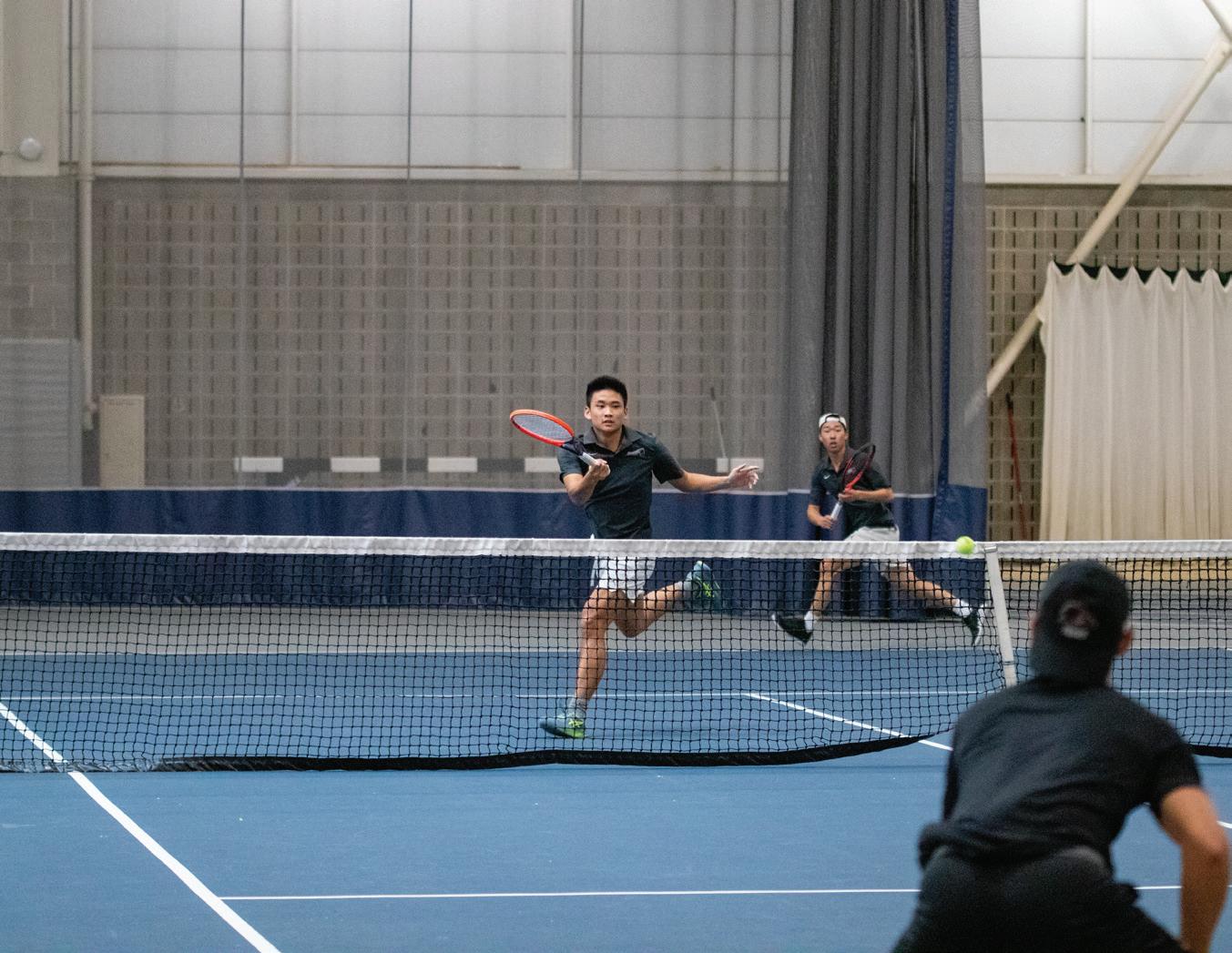
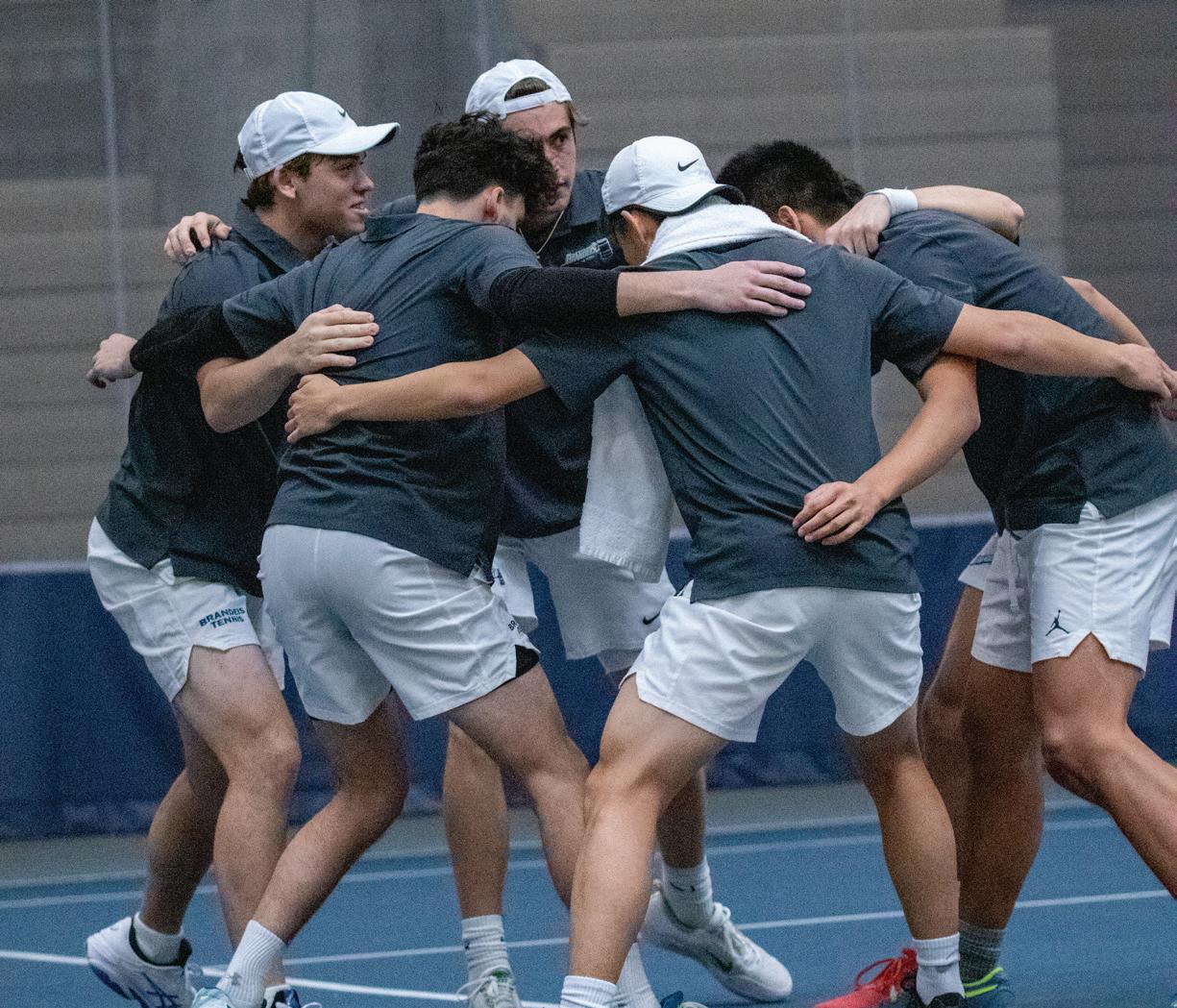


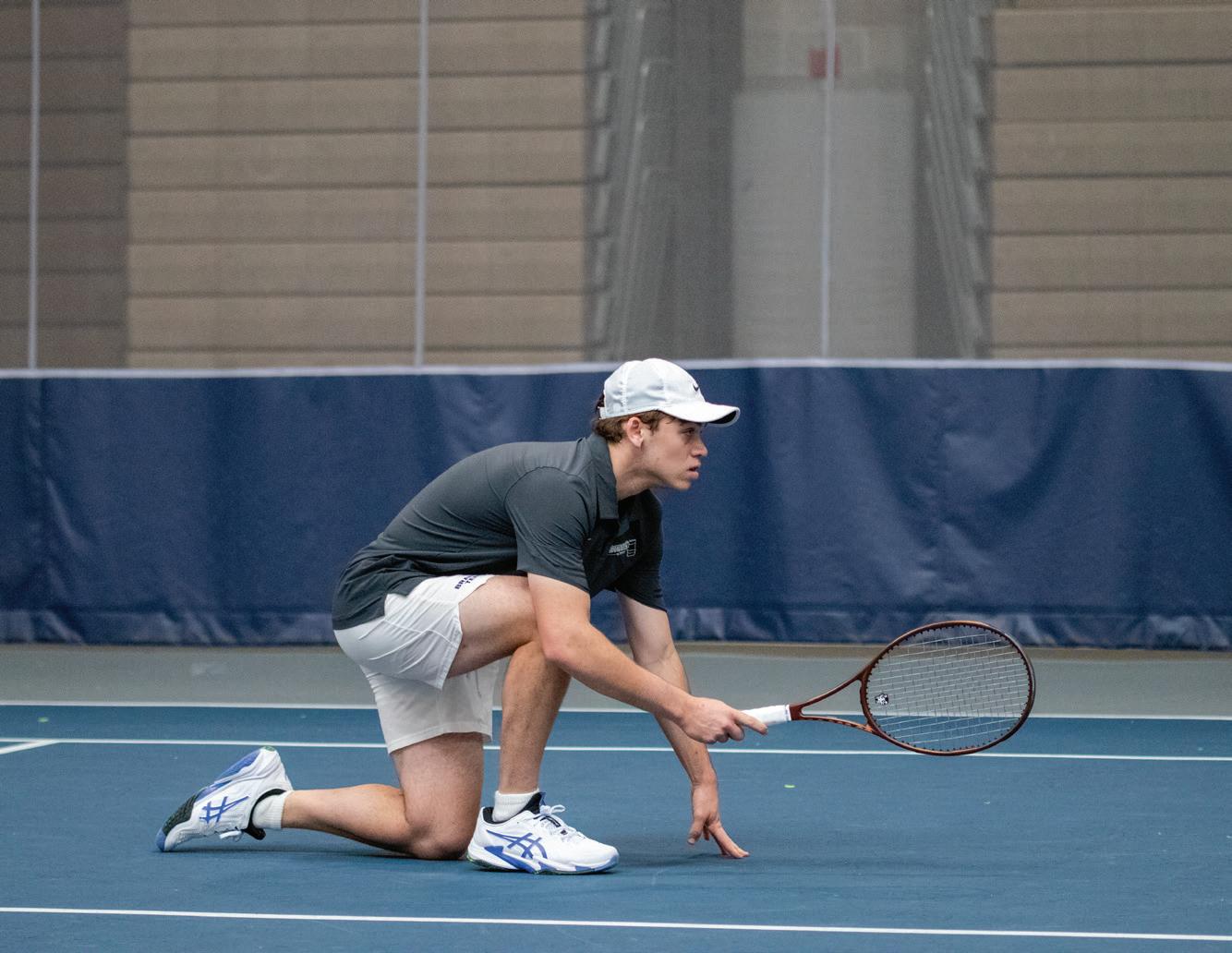
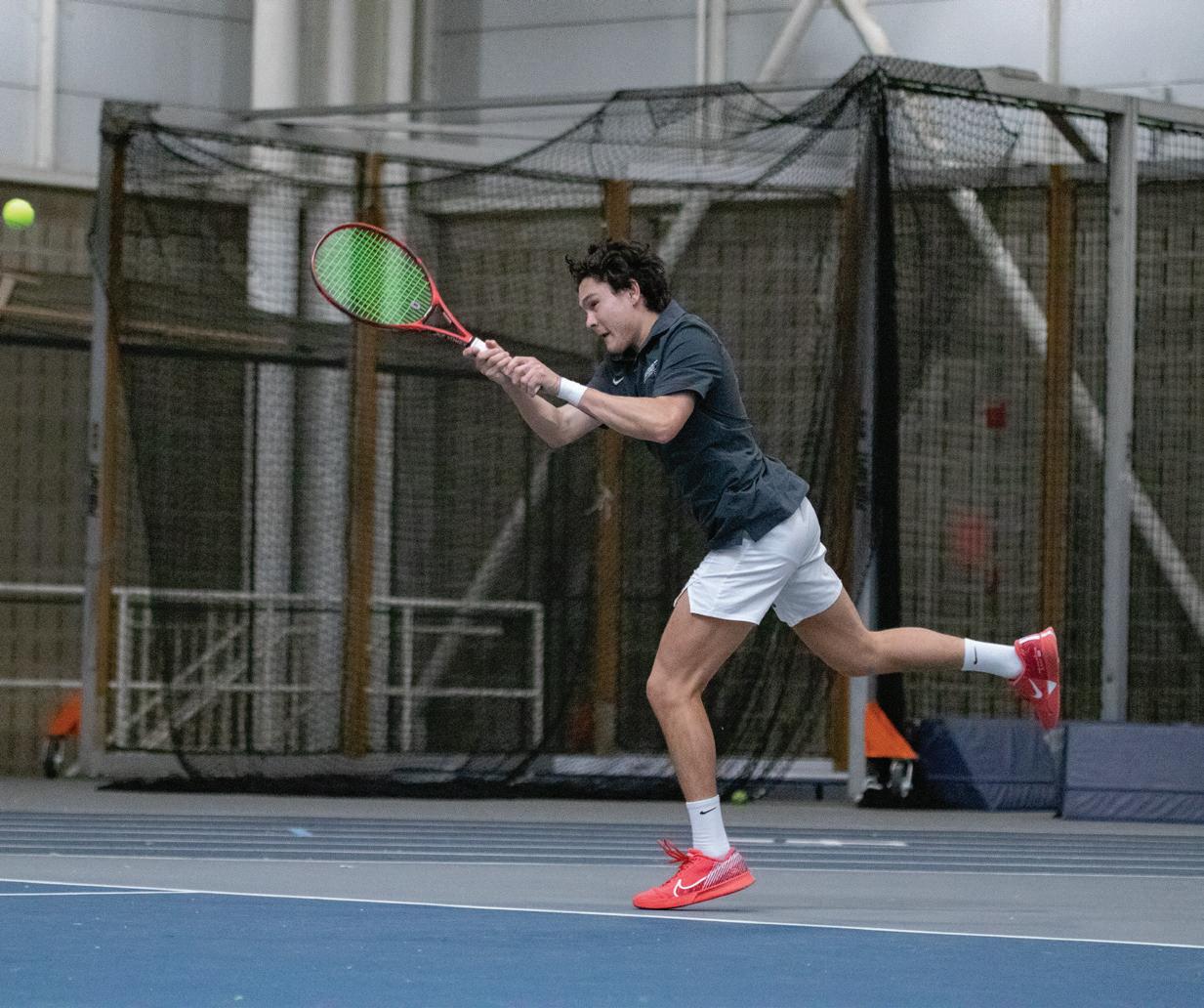
UPCOMING GAMES:
Eastern Nazarene College
Thursday vs. Massachusetts Institute of Technology

Saturday at Colby College (DH)
Sunday vs. Anna Maria College
Total RBIs

Sean Decker-Jacoby ’24 lead the team with 10.2 innings pitched.

Total RBIs Total Innings Pitched
to the increased size of the audience, allowing for easier player identification. These larger numbers are a traditional aspect of all outdoor NHL games.
The Philadelphia Flyers have presented a white jersey with the traditional team logo on the front. This jersey has a large orange stripe and a smaller black one with the player name. Orange numbers are on the shoulders and the stadium patch is on the sleeve. This is the third stadium series that the Flyers have played in, with the first two jerseys being orange and black. This white jersey completes the set of three. Many fans were hoping to wear these special edition jerseys to the game, but this is impossible. The Wells Fargo Center website stated that “by pre-ordering you are guaranteed to receive a 2024 Adidas Authentic NHL Stadium Series jersey. Due to supply chain issues 2024 Adidas Authentic NHL Stadium Series jerseys are expected to arrive on/around March 15.”
Overall records -
MEN'S
STANDOUTS
Singles
Dylan Walters '24 leads the team with a record of 10-5.
Doubles Tommy Harrison '26 and Dylan Walters '24 lead the team with a record of 7-3.
UPCOMING MATCHES:

Saturday vs. Rensselaer Polytechnic Institute
MEN'S
STANDOUTS
Singles
Bhakti Parwani '25 leads the team with a record of 4-3.
Results from the NCAA Regional Championships on Mar. 10
Foil
UPCOMING MEETS:

Men: 1-5 Results from the NCAA Indoor Championship at Virginia Beach, VA on Mar. 8.
The New Jersey Devils have released a primarily red jersey with black accents. This was a very exciting moment for the Devil community, as the last stadium jersey they released was the green and red throwback, while other teams had new and modern jerseys. The Devils have also recently released the “Jersey jersey,” another modern take. Before the departure of general manager Lou Lamoriello, the
team usually took the safe route instead of stepping outside of the box, but Lamoriello has since moved to manage the New York Islanders. The Devils logo on this jersey is missing the traditional circle behind it, the first time that the logo has been seen on its own. They have released many pictures of these jerseys, including them being held by the Jonas Brothers, but the presale has not yet been released. As this is the first time the event has been held in their state, fans are hoping that they will be able to wear their jerseys to the game. The New York Rangers jerseys have red and blue accents on a white background. Reimagining the classic, the normal word of “Rangers” has been changed to the initials “NYR” in order to be shown bigger while using the same font and drop shadow effect. These letters are still shown in the stairstep orientation, a staple of the team. The red and blue stripes on the sleeves are the same as those on their road jerseys, just at a bigger scale to accommodate the bigger size of the stadium. These jerseys, once again, are not guaranteed to arrive in time for the game, with some having a shipping estimate of mid-March, almost a month post-play. Additionally, these jerseys are priced at a higher rate than the other teams, and fans are outraged because the Stadium Series patch is not a part of the jersey itself, needing to
be purchased and applied separately if desired.
The New York Islanders have gotten the most backlash on their new jersey. They are navy blue with a very large orange stripe across the middle. This color-blocking effect is used as an homage to the plimsoll line on hulls of ships. The word “Isles” is printed across this orange strip, a nickname given to the team by their large fanbase. According to the NYI Instagram, “ISLES is set in the center of the jersey to showcase the pride and passion for the team that our fans bring to every Islanders game.” These jerseys got the most negative responses by far, being extremely unpopular with the fanbase. Once again, many of these jerseys are not set to ship until Mar. 15, leaving fans jerseyless and disappointed for the big game.
The Stadium Series jersey release garnered a wide range of opinions. Fans are widely disappointed by shipping dates and high prices, but excited by the upcoming games. Fans will be flocking to MetLife stadium in mid February, but many won’t be wearing these new jersey designs. The only way that fans will be able to get them on time is to visit the NHL store in New York City or the respective team stores, where they are in very short supply.
Hannah Du '26 made the top 21 fencers.
Epee
NCAA Championships at Ohio State on March 21 - 24
Doubles Bhakti Parwani '25 and Rebecca Suarez '26 lead the team with a record of 9-2. UPCOMING
CONTINUED FROM 16
senior infielder Tiare Jennings, and Gasso commented on the latter’s incredible ability to clutch up and get runs across in tight situations. However, Louisiana’s junior catcher/infielder Sam Roe notched two key RBIs and four other Cajuns stayed strong offensively, contributing to the win.
From the bullpen, Sooners’ grad students Kelly Maxwell and Karlie Keeney just about split the game in innings pitched, with Maxwell recording three earned runs and Keeney holding Louisiana to one earned run. The Cajuns’ sophomore pitcher Chloe Riassetto held Oklahoma over eight innings, with four earned runs.
This game certainly was lost because of the errors committed by Oklahoma, an unusual outcome for them, as the statistics show that the game was held close until the Sooners lost control defensively.
Fiona Doiron ’25, a member of the Brandeis Softball team, like many other softball fans, was shocked by the outcome of the game. But she aptly noted “Louisville took advantage of Oklahoma's defensive errors, which are extremely rare, and that's what teams will need to do if they want to beat Oklahoma. I was even more shocked that the NCAA rankings had Oklahoma ranked 2nd after their loss and Texas ranked #1, but I think this was good for Oklahoma to face adversity early
in the season if they want to continue dominating as a program. College softball has been dominated by Oklahoma for the last 3 years, and I think that other teams are slowly catching up. This year will be more competitive, which is good for the growth of the sport.”
The Sooners have won the past three consecutive WCWS, a streak they will be sure to fiercely protect as this season progresses. But will their bats keep them alive and their heads stay in the game or will a mental slip-up like the errors in this game keep them from continuing their dynasty? There are still plenty of games left in the season, so only time will tell where these powerful softball teams will go next.


Gilbert Otoo ’25, a transfer guard/forward from Trinity College, is a member of the Brandeis Men’s Basketball team who came into the 2023-2024 season ready to make an impact. The Maryland native earned a University Athletic Association Honorable Mention selection at the end of this season and averaged a whopping 11.2 points per game, leading the team. In the Judges’ first conference win against Carnegie Mellon University, Otoo had a teambest 20 points and 10 rebounds, greatly contributing to the 78-61 victory. He also put up 20 points in Brandeis’ second matchup with Carnegie Mellon, continuing his hot offensive streak.
In high school, Otoo was a four-
year varsity player and received a coaches award as one of the senior captains of the team. He worked in a lab researching biomechanics and volunteered at the local soup kitchen.
The Biophysics major was born and raised in Ghana for six years and loves to hang out in the Barry Harsip Student Lounge in Gosman. When the weather gets warmer, he enjoys having Ben & Jerry’s Chunky Monkey ice cream. His music taste ranges
■
By RANI BALAKRISHNAThe University of Oklahoma's softball program and their head coach of 29 years, Patty Gasso, are arguably some of the greatest of all time when it comes to collegiate softball. Their 71-game win streak began in 2023 as they ended their season with 53 straight wins to close out the regular season. The Sooners then capped it off by winning the Women’s College World Series in 2023 and kept their win streak going until the Louisiana Ragin’ Cajuns broke it with a 7-5 victory on Sunday, March 3, 2024.
Oklahoma’s last loss before March 3 was over a full year ago to Baylor in 2023, a statistic that has cemented their legacy in softball history as one of the greatest programs of all time.
Playing in Norman, Oklahoma on the Sooners’ home field, the Cajuns started the game strong scoring in the second and fourth innings, but the Sooners answered in the bottom of the fourth. Despite Oklahoma tying it
ICE HOCKEYup 4-4 in the seventh inning, it wasn’t enough to put away a 19th straight win for the home team. In extra innings, Louisiana pushed three runs across with the Sooners only responding with one run back, resulting in the 7-5 win for the Cajuns.
Oklahoma’s downfall was primarily due to defensive errors, as they committed a season-high of three errors, the most they had since the 2021 WCWS. This being their first loss at home since February 2020 ended the most impressive win streak in Division 1 softball history.
Oklahoma’s dominance has reigned supreme in the softball world for the past 30 years under Gasso, as she has coached the Sooners to seven World Series victories. The team’s star-studded lineup and long legacy of elite athletes tend to keep the Sooners at the top of Division 1 softball rankings. However, as of March 11, Oklahoma sits at the NCAA’s number 6 position in overall rankings.
According to Sports Illustrated, Gasso even commented, “We had the spirit of coming back which was great … But from defense to pitching to timely hitting, we wasted a lot of time early in the game. This was a game we didn't deserve to win.”
Key hitters for Oklahoma were their senior utility player Alyssa Brito and
See SOFTBALL, 15 ☛
■ Over 130,000 tickets were sold as fans flocked from near and far to the NHL Stadium Series this February.
By ANNA MARTIN JUSTICE EDITORYork Giants and the New York Jets of the NFL.
Each of these games will be accompanied by a concert performance from a popular musical group. On Feb. 17, the New Jersey Devils will face off against the Philadelphia Flyers following a pregame concert by the New Jersey natives, the Jonas Brothers. AJR will play an intermission concert during the game between the New York Rangers and the New York Islanders on Feb. 18.
One aspect of this once in a lifetime event is the release of a Stadium Series jersey for each participating team. Occasionally, these new designs have ended up becoming the team's regular alternate jerseys, which has happened
for both the Flyers and the Islanders in the past. The Flyers are still currently wearing their 2017 Stadium Series jerseys as their alternates. This jersey release was coupled with extensive advertising from the NHL. The primary video commercial showed models wearing the jerseys in a subway station, representing the primary mode of transportation in the metro area. This video was shot in a retro style, showing the jerseys worn in a casual setting rather than on the ice. Additionally, the Devils held a media shoot, showcasing many of their players wearing the jerseys. The Flyers held a shoot outside, being the first team to reveal the entire game day outfit. The Islanders and the Rangers both posted breakdowns of the meaning behind all aspects of the jerseys but did not publish media from an additional extensive shoot.
All of the jerseys worn on the ice will be equipped with a patch of the 2024 Stadium Series logo which is specifically designed for the event, bringing in specific elements that will not be seen again. The background of this logo takes the shape of New Jersey, where these games will be played in. This is the first Stadium Series to take place in New Jersey. The lines at the top of the logo mirror the architecture of the MetLife stadium. The green piping around the outside of the logo references the nickname of New Jersey as the “garden state,” the same phrase printed on the state license plate. One additional special feature of these jerseys is the number size. They are printed much larger than normal due
See NHL, 15 ☛
Men's tennis hosted Franklin Pierce University in a match on Saturday, March 9 at Gosman, p. 14.

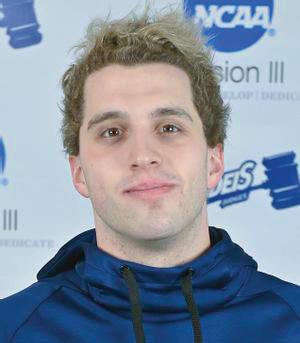


and never counted himself out [of the] season.” This could be seen in this season’s performance when he improved his 1650-yard freestyle time at the 2024 University Athletic Association Championships by 21.25 seconds, for a season's best time of 15:36.71. This gave him second place in the conference meet and ranked him tenth in Division III, earning him a spot at the 2024 National Collegiate Athletics Association Division III Championship.
Sam Dienstag ’24, TJ Carleo ’26, Rebecca Suarez ’26, and Haley Nash ’24 earned UAA Athlete of the Week honors for the weeks of Jan. 22, Feb. 5, Feb. 11 and Feb. 25.
Sam Dienstag ’24 For the second time this Swim and Dive season, Dienstag earned another UAA Athlete of the Week honor for the week of Jan. 22. This is his third overall honor, his second from the beginning of the season in October He earned this honor upon his first returning meet — the final home meet of the season — after being ill with infectious mononucleosis for much of the season. Leading the way for the Judges against Keene State, he placed first in the 1650-yard freestyle with a time of 15:57.96 and first in the 500-yard freestyle with a time of 4:47.65. In an interview with The Justice on March 8, when discussing being out with mono for the majority of the season, he says he “keeps persevering
At the UAA Championship, he also earned an additional spot to nationals with his win in the 500-yard freestyle with a time of 4:25.83, ranking him fifth in Division III.
When discussing the upcoming national championship, he said he was “looking forward to nationals, I just want to do my best and finish strong.”
This positive mindset doesn’t seem to come from nowhere, as Dienstag started his career at Brandeis during the fall semester of 2020. This meant for his first year he couldn’t train with his teammates due to COVID-19 regulations. In an interview with The Justice, head swim coach Nicole Carter said, “He's grown so much socially, leadership wise, all those types of things. So I really just want him to end it on a confident note.” Carter continued, saying, “No matter what happens, when the last race is done I hope he's proud of what he's done, no matter what the clock says.” This support clearly had an impact on Dienstag and hopefully we will see the positive effects of this support on Dienstag’s per-
formance next week.
TJ Carleo ’26
For the first time in Carleo’s collegiate indoor track career, he earned another UAA Athlete of the Week Honor for the week of Feb. 5, his second overall honor. He earned this honor at the Tufts University Cupid Invitational with a second-place finish in the 800-meter run, with a time of 1:54.31, which when accounting for the flat track, this converts to 1:52.70, which ranked him 16th in NCAA Division III. Since then he ran on the fastbanked track at Boston University’s David Hemery Valentine Invitational getting a time of 1:51.58 — just 0.54 off of the indoor school record — which also earned him another Judges of the Week award. He then went on to place second in the 800 meter at the 2024 Indoor UAA Championships, which also earned him another All-Association honors. He then further improved his time at Tufts National Qualifying Meet on Mar. 2 in which he managed to run a 1:52.43, which converts to a 1:50.85, which ranked him 11th in Division III and secured his ticket to the Division III Indoor National Championship — his first ticket to indoor nationals and his second overall. At the national championships, he unfortunately was not able to keep up with the fast-paced heat, as the leaders of the heat and top seeds of the preliminary round all came from Carleo’s heat. He kept up with the leaders as they went
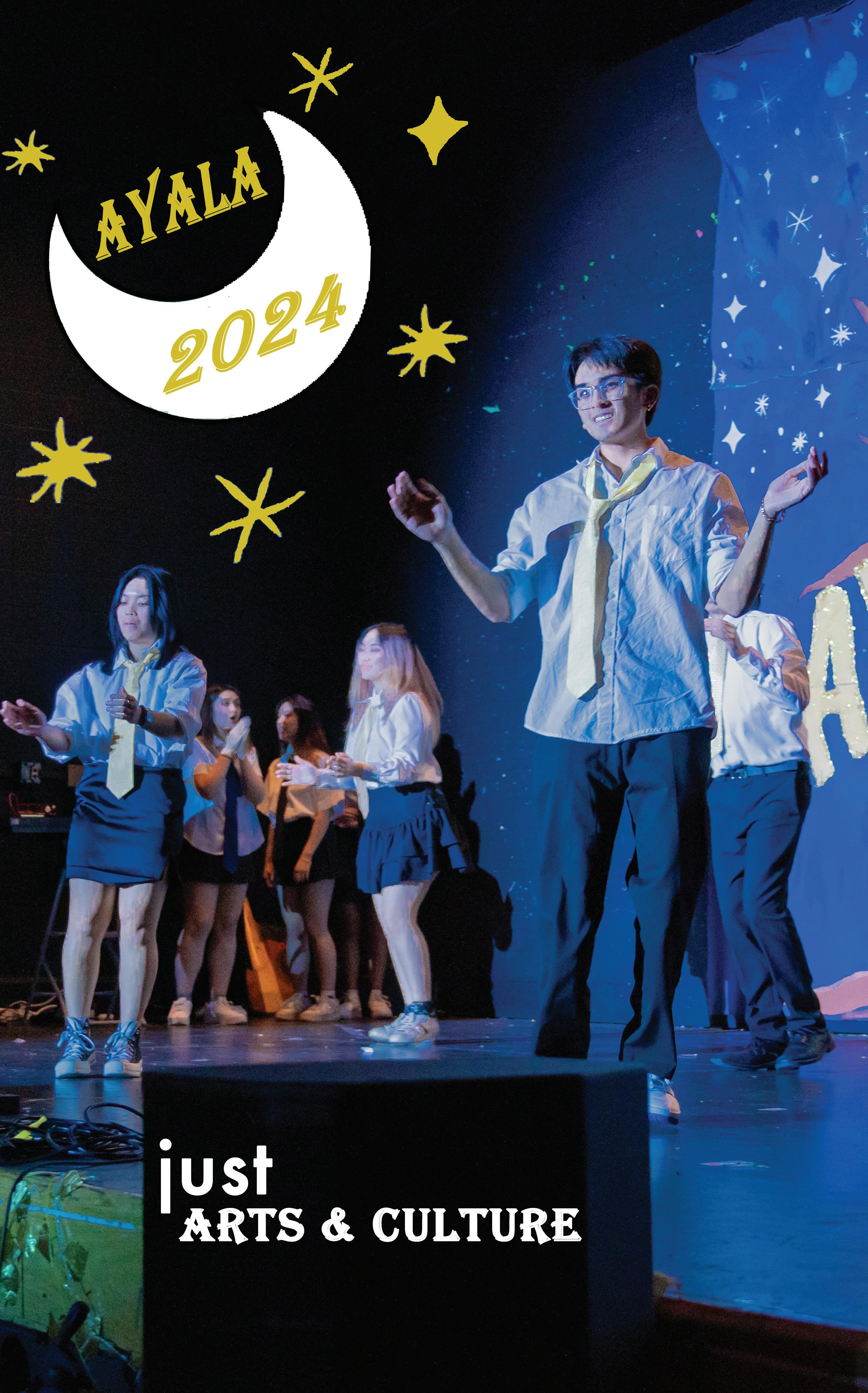
On Saturday, March 2, Hypercube performed musical pieces composed by current Brandeis students as a part of the Brand New Music concert series. Hypercube is a quartet that pushes the boundaries of chamber music, with a focus on performing cutting-edge new music. Last weekend, they performed never-before-heard pieces by Brandeis composers.
The concert began with music Ph.D. candidate Ying-Ting Lin’s composition “Press F to practice I”, described on the program as “stand[ing] at the precipice” of the artisan’s touch and AI’s prowess, acting as “a beacon in the fog of progress.” The piece was the only solo of the concert, played by Erin Rogers on saxophone. Rogers employed techniques that transformed this singleinstrument performance into a one-woman band showcase. The performance began energetically, with a mysterious backing track accompanying the saxophone, producing a sound akin to a frustrated, barking puppy. The sound could best be described as “frightening” with the noises of the saxophone reminiscent of a squeaky violin, deep overtone singing and a dramatic horror movie soundtrack at various moments in the piece. There were brief moments of jazzy respite, with more traditional saxophone techniques and riffs, but the piece always returned to the avantgarde style it established. Rogers is clearly a very talented performer to be able to pull off this composition, but this piece, which is excellent in theory and important to the discussion of music’s future with AI, fell flat in terms of my expectations of the aesthetic experience music should produce. It challenged my idea of what music’s goal should be but left me with an unpleasant listening experience that made me unsure of the future of composition.
The next piece, “A Liminal Space in Memoriam Phill Niblock,” composed by graduate student Sam Long, was dedicated to “New York minimalist and champion of experimental artists” Phill Niblock. The program explains that
the piece “explores his harmonic relationship of long sustained pitches, psychoacoustic phenomena, and sound’s relationship with architecture.” The piece included white noise in the background that at times blended with the instruments but sometimes overwhelmed them. The white noise reminded me of a dentist’s drill and made my head buzz in a confusing sensory experience. The percussionist, Chris Graham, circled a gong, instead of hitting it. The piano player, Andrea Lodge, hit the strings inside the piano with a ball attached to a stick. The guitarist Jay Sorce scraped some sort of tool against the strings. The saxophone blended in with the white noise, making it hard to differentiate between the noise and the sounds of the instruments themselves. There were some moments where the instruments were played as they were originally intended, with occasional moments of harmony, but the return to the abrasive white noise was always soon to follow. There was a period after the performance ended where the audience was allowed to sit and process what we heard, and silence took on a new meaning for me. The program definitely delivered on its description but it was generally an unsavory experience and I wouldn’t recommend it to anyone with dentophobia — a fear of the dentist.
“Love is the Water of Life” from Ph.D. candidate Ali Can Puskulcu, was inspired by a poem by Sufi poet and mystic Rumi. The composition “navigat[es] the intricate makamsal — Turkish microtonal music — pitch series” while inviting “contemplation and reflection.” Throughout the performance, the percussionist would whisper into a paper cone unintelligible phrases that I assume were the lines of the poem. There was a clear Turkish style established that lent itself beautifully to the performance. There were primarily higher notes in the first part of the performance, with riffs given to each instrument. A pleasant interlude of charming jumps happened between the saxophone and percussion with the guitar and accordion, played by Lodge, soon followed. A quick departure was sparked by the percussionist loudly banging on the drums and
the saxophone having an argumentative-sounding solo. An explosion of sounds from all of the instruments followed. The percussionist then switched from drums to making cricket-like noises, then noises that sounded like stomping and slamming a door. A brief but impressive guitar solo happened before the cricket noises returned. The accordion was granted a solo that gradually grew in intensity and culminated in Lodge slamming the piano keys before another lengthy reading session from Graham accompanied by a shaker. This composition very impressively mixed the avant-garde elements of the other performances of the concert with more traditional-sounding elements. The reading was an interesting addition to an instrumental piece that I enjoyed hearing. However, I would have preferred clearer enunciation so the audience could hear the poem and understand how the composition accompanies it.
The next piece, “Cat(meowmeow),” by music masters student Brandon Qi had harmonic content “directly taken from [his] cat — named Piano — stepping over [his] piano.” The “Latininspired” piece switched out the electric guitar for an acoustic one and the alto saxophone for a soprano saxophone. This very pleasant, jazzy-sounding piece included contrasting melodies and an evident influence from Piano, the cat, on the piano. The traditional drum kit was a good addition to the ensemble. I hope “Cat(meowmeow),” and its balance between aesthetically pleasing sounds and more experimental, avant-garde sections, is indicative of where the future of composition is headed.
Undergraduate student Grace DeRoche ’24’s “Arcadia Nouveau” was the smoothest composition of the night. It is described as “a reflection on the idea of space, and what it means to inhabit” space, referring to natural, industrial and digital spaces that make up our lives. This piece works to instantly put its listener in a good mood with its gorgeous piano melodies accompanied by the xylophone as it explores the interaction between the “spaces that color our lives.” The guitar and piano were stand outs in this work, but all of the
instruments worked together beautifully. The sole word I would use to describe the listening experience of “Arcadia Nouveau” is “lovely.” I didn’t experience the themes described in the program as clearly as with other performances, making the piece less conceptual. Nevertheless, it was a special and welcome break from the more jarring, experimental pieces.
The final performance of the night was Composition Ph.D. student Yu-Tung Cheng’s “Fish Study I: a thought swimming through and it’s mostly about food and sex.” The piece is inspired by Cheng’s “grumpy [seven]-month-old betta Roi” and “delves into the physical vibrational interactions among fish underwater, envisioning potential topics of their gossip.” The unique description, which included transliterated fish noises of “grrr ggr’ bulbbblgrr blupppp legrl” set my hopes pretty high. The performance started on an aquatic note with the percussionist making a pulsating sound by circling his finger around the rim of a glass of water before diving into a drum introduction. A backing track was played that felt disconnected to the instruments. There was a pause and a gentle return that was marked by the disjointedness of the noise. The minimalist piece included alternating from infrequent playing to explosions of sound but ultimately the composition felt empty and incoherent.
The experience of seeing how Brandeis students push the limits of composition made for a very thought-provoking evening. Whether or not I enjoyed each composition, they all gave me a lot to think about. Where is the future of music going? What are the goals of music? What is held sacred in composition and should it be sacred? What are the limits of an instrument? These questions are pivotal to my understanding of both modern music, modern art and literature as a whole, especially as it relates to artificial intelligence and the new digital age we’re in. I would highly recommend attending one of the upcoming performances of the Brandeis Concert Series and reflecting on the questions that it provides you with.
n The Department of Theater Arts show had four performances this past weekend, including a talk with the visiting writer.
“What if I said I am not what you think you see?”
The opening line of “Wolf Play,” written by Hansol Jung and directed by Sarah Shin, sets the mood for an emotional journey following the story of a young Korean boy adopted by a queer couple. Throughout the story, the audience witnesses the arc of the young child initially struggling to adapt to a new household, working through behavioral differences and finally finding a place within his new ‘pack.’
The Brandeis Department of Theater Arts’ spring production of “Wolf Play” delighted audiences with four different performances this past weekend from March 8-10. The five-person cast was incredibly talented and put on a moving performance on Friday night, Saturday afternoon, Saturday night and Sunday afternoon.
Playing with the imagination of the audience, the set and storyline emulated childlike, innocent ideas. Wolf-boy was this dual character played by Phoenix Yuan ’26 holding a puppet made out of various materials, including cardboard and plastic bags. The Wolf is the way the boy, Jeenu, expresses his personality. However, the Wolf is an alter-ego, as Yuan had lines on his own and then also lines holding the puppet. This duality allowed the audience to take in the actions of the actor and the actions of the puppet as separate at times but simultaneously the same being. The use of the well-crafted puppet and other ambiguous scenes gave the audience autonomy, inviting us into the conversation. The script also included informal and humorous dialogue such as knock-knock jokes and intimate moments between the lead of Wolf-boy and the audience.
The Saturday matinee had a special panel made up of Jung and Shin and was moderated by Kelly Mee Rich, associate professor of English at Harvard University. The talk, presented by the Department of Theater Arts and the Department of Asian American and Pacific Islander Studies was very insightful. The three discussed topics from incorporating Korean culture into the production to topics of family and togetherness. The adopted community also came up, and in response to how to best represent the narratives on stage, Shin commented that it came down to who her actors and actresses were. She got to know them personally and then put her twist on what she thought would be the best representation of the character. Jung noted that there were several avenues of writing the play that were not taken, and how intricate differences between different productions of “Wolf Play” highlighted different aspects of her writing.
“Easter eggs of Korean culture” were also worked into the play, and the malleability of it allowed the five-person cast to put their own spin and creative freedom on the writing. One attendee asked the director and writer how they reckoned with conveying a transracial adoption story and how they grappled with white guilt in the wake of it. Both Shin and Jung responded by stating that theater is an art where academics learn how to come to the audience, so when conveying a message, artists let the audience come to them. Dynamic scenes, fun sound effects and the use of a puppet kept audiences engaged. Scenes used the audience in “talkback” and jokes, a unique approach not often seen in formal theater.
Breaking the cycle of external expectations and traditions were other goals that Shin and Jung aimed for, along with emulating the essential values of theater. One of them held space for the fact that “the only thing that feeds love is imagination. Anything can feed hate.” The imaginative aspects of the play meant that each member of the audience took their own life lessons from the performance with them.
Liza Heck ’25, who brought the non-binary character Ash to life, commented on what the play meant to them, saying, “The process and production of ‘Wolf Play’ were entirely unique from any other theatrical production I’ve worked on — the experience of a world within which we explore topics including adoption, gender and found a family through the conduit of play and joy. Having such a tremendous amount of trust in the people within the space created a process that encouraged us to be authentic in ourselves and our characters such that the expression of truth was multidimensional. ‘Wolf Play’ taught me collaboration, empathy and love in its purest form.”
I attended the Friday night performance, the talk with the director and playwright and the Saturday night performance. Both times, the cast stunned me with their ability to convey larger-than-life meanings. Life lessons of creating your own family, queer and adopted family affirmations and a comical, emotional journey
brought me and other viewers to tears. The comedic timing, set, acting and directing all combined to portray a really powerful story.
“Wolf Play” was an excellent selection for a department show, as it created the space for students to come into their characters as they wished and provided a storyline to affirm and bring to life the untold stories of the adopted, queer and Korean communities.
“What if I said I am not what you think you see?” was repeated in the last scene of the play. The repetition of this line made it stand out individually to the audience. The final line, “Does this change anything?” is reminiscent of the human aspect of theater and how profound storytelling can be.
The cast consisted of the Wolf played by Phoenix Yuan ’26, Ash played by Liza Heck ’25, Robin played by Rachel Shpuntoff ’26, Ryan played by Matthew Magee ’25 and Peter played by Sam Taxman ’27. Understudies included Helen Ma ’27, Arushi Choksi ’27 and Chris Li ’24.
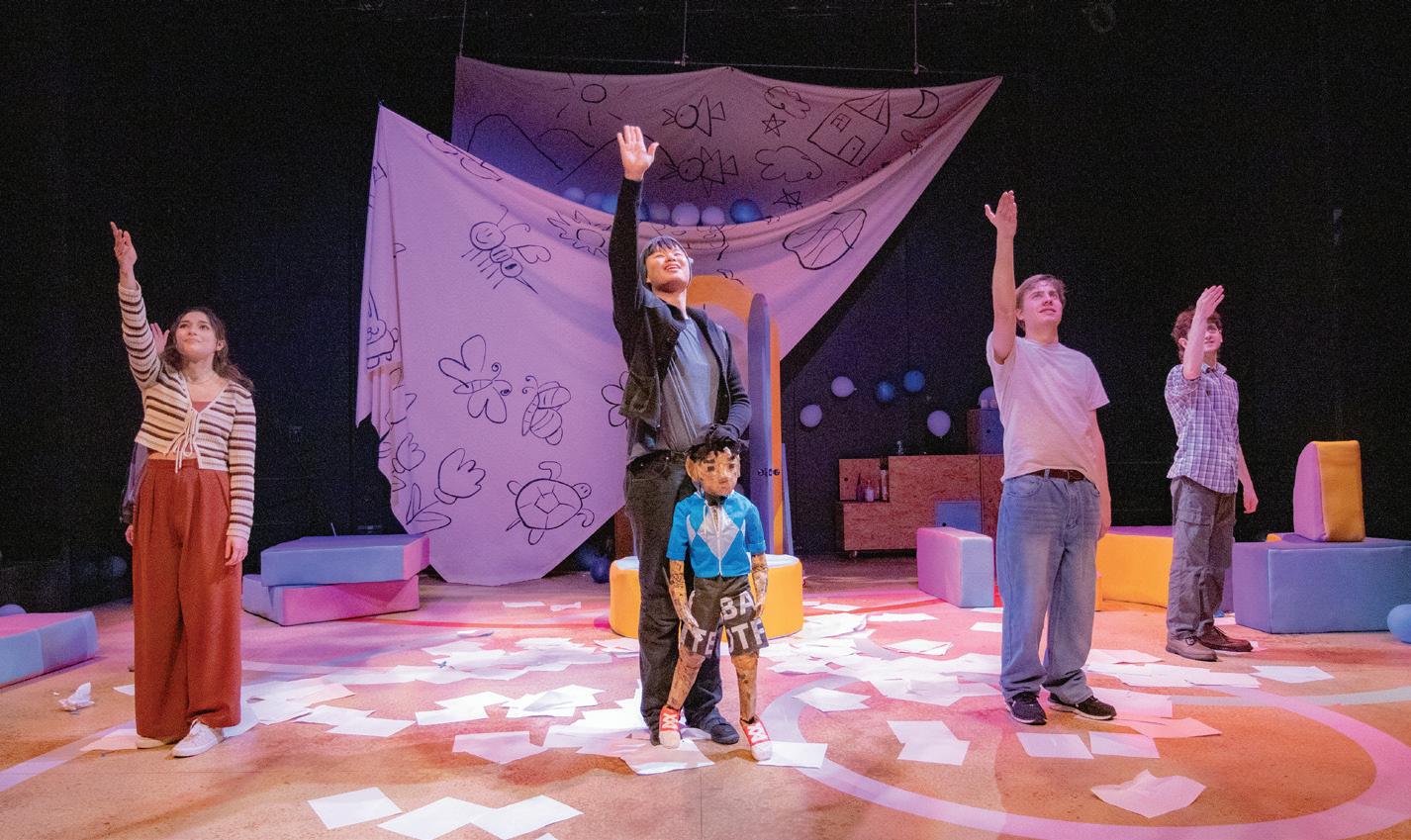
n Oscar nominated documentary “Flee” used animation to preserve anonymity and allow a safe space for a refugee to share his journey.
The animated documentary “Flee” is full of powerful moments and visuals that touch the hearts of many viewers, earning the documentary an Oscar nomination. The film is centered around the character of Amin, a man who became a refugee from Afghanistan, as he tells the story of his childhood to a friend whom he met later in life. The animation techniques used in this documentary set it apart from the others I have watched, making it an especially enjoyable and impactful work.
The Hollywood Reporter states, “Amin initially balked at [the director’s] idea to make a movie about his experience. But then came the idea of an animated film, primarily to tell the story while still giving Amin his privacy.” While unusual, this technique gives the opportunity for anonymity that would not have been possible through the traditional live action format. This likely encouraged Amin to be more vulnerable with the director and to share some stories that may not have otherwise been included.
While animation is not usually a genre that I gravitate towards, I do not feel that the film would have been the same in any other medium. Documentaries focusing on the past often need to consist of found footage from various news sources and personal collections. In contrast, animation creates the opportunity for such moments
such as close-up shots of facial expressions, in turn showing the deep emotions felt by the characters on screen.
One particularly powerful scene of the documentary depicts Amin and his mother on a boat escaping Russia when it comes in contact with a large cruise ship from Norway. All of the passengers on the small boat are thrilled by the sight of this ship, as they see it as an opportunity for freedom. The animator uses perspective as a tool to illustrate the difference between races and opportunities, as the large cruise ship looms over the very small boat. This size difference illustrates where the two groups of characters are coming from and where they dream of going, while the refugees hope of building better lives for themselves.
The perspective of the animation is very effective at placing the audience in the boat with the refugees, instead of looking at the scene from an objective perspective. Brilliantly, this strategy builds empathy for Amin and his mother, as well as the other refugees on the boat. By placing the audience in the boat alongside them, we are overcome with feelings of hopelessness, facing dreams that seem almost impossible to achieve.
The animator also illustrates the boat holding the refugees from the perspective of the people on the cruise ship. The boat looks small and insignificant from this downward facing angle, demonstrating how little the people from Norway care about those below them in comparison to the high level of desperation felt by the refugees on the boat.
One of the main themes explored by the director in this scene was the sense of embarrassment felt by the refugees. Amin felt
Remembering Navalny and Markvo through art and activism
By NEMMA KALRA JUSTICE EDITOROn Feb. 16, two individuals from Russia who embodied the essence of resistance passed away: Alexei Navalny, an outspoken opposition politician, and Dmitry Markov, a renowned photographer and social worker.
In his time, Navalny was a well-known and respected leader of the Russian opposition against President Vladimir Putin. For years, Navalny exposed and combated the high level of corruption present in Russia’s government. His political pursuits placed him under direct fire from the Kremlin, so much so that in 2020, Navalny was allegedly poisoned by a toxin akin to Novichok, a Soviet-era nerve agent. In addition to attempts to end his life, Navalny’s political work led to numerous arrests and charges of extremism, ultimately culminating in a 19-year prison sentence in a remote prison north of the Arctic Circle. While in prison, Navalny unfortunately passed away due to reportedly undefined circumstances.
On the very same day of Feb. 16, social worker, artist and supporter of Navalny Dmitry Markov passed away. Markov was a prominent photographer, documenting all aspects of Russian society largely from his iPhone. Many of his photographs tie into his community service work and political resistance, one of his most famous being a photograph he took after being detained in a 2021 rally in support of Alexei Navalny. The photograph depicts a riot policeman sitting underneath a portrait of Vladimir Putin. Following the virality of his photograph, Markov auctioned the picture off for 2 million rubles (approximately $22,000) and donated the proceeds to OVD-Info and Apologia of Protesta, organizations that aid detained protestors. Markov used his art to support his communities and champion the social reality he believed in.
In the midst of extreme political turmoil and violence, art is a powerful tool for fostering community, expressing resilience and voicing resistance. In honor of the art of Dmitry Markov and the political work of Alexei Navalny, the Brandeis Russian Club created an exhibition featuring many of Dmitry Markov’s photographs. The exhibition celebrates the legacies of the two activists while creating the space for students to send their own sentiments of freedom and hope to the countless political prisoners being held in Russia. In a Google Form made to collect students’ messages, Brandeis Russian Club explains, “Many of these prisoners are about your age, some are students. You can brighten their day by writing a short message.” Brandeis’ Russian Language Program plans to translate and send the messages to the political prisoners. The Brandeis Russian Club’s exhibition, as well as their initiative to bolster support for those jailed for their oppositional views, can be seen in the atrium of the Shapiro Campus Center. While these two lives have been lost, those both inside and outside of Russia are working to honor their legacy and leave the world a better place than they found it through the use of art.
uncomfortable with his position as someone begging for help. Midway through the scene he states, “I don’t know why, but as I stand there looking at the ship, I just can’t feel the joy,” as those around him are all waving and yelling with happiness. They feel that the people more fortunate than them will extend a helping hand while he is ashamed to be in this position in the first place. This is clearly shown by the emotions on Amin’s face when compared to the others around him. He has his head down with a look of shame, while his mother beside him has her hand raised, and a hopeful look in her eyes. Asking for help is never an easy undertaking for anyone, as it is often stigmatized and tied to factors such as race and gender.
The vacationers from Norway are illustrated with blank and empty looks on their faces, displaying a lack of compassion towards the refugees. Their faces lack the detailed depth and dimension that is shown in the faces of the refugees, instead appearing flat and apathetic.
When the ship informed the refugees that they would be sent “back to where they came from,” the animation clearly displayed looks of shock and horror across all of their faces as their dreams faded away.
As shown through the integration of live action footage directly following this scene, the refugees ended up spending a large amount of time in a refugee camp where journalists came in, reported and then left. This pattern mirrors the tourists on the cruise ship taking pictures of the refugees hoping to be rescued, instead of working to help them obtain better lives.
I found the integration of live action footage to be very effective. I think that insert-
ing clips from news sources into an animated documentary kept it grounded in reality, reminding the audience that even though real faces were not seen, real people were greatly affected.
The live action footage of the refugee camps ultimately illustrates the idea that people use those in need for personal gain such as profit from work or entertainment, rather than working to find a solution that could help them live better lives. People dismissed the wellbeing of others, instead harming them further than if they had just left them alone.
The documentary poses a complicated concept that is discussed a lot in the journalism world and has no true answer. Involving yourself in a situation ultimately invalidates the legitimacy of your journalistic piece due to it no longer being objective. However, profiting off of the misfortune of others by telling a story that you took for free also seems wrong.
As such, through its unique artistic techniques as well as its depiction of Amin’s story, the documentary calls into question the balance between truthfully representing people’s stories and supporting oneself as a journalist. How do realistic pieces of media balance entertainment and assert their right to exist without sensationalizing or commodifying the struggles of others? When covering sensitive and personal subjects, it’s hoped that the broader reach of journalistic pieces and their potential to inspire others to offer support will ultimately yield greater positive impact than any individual efforts. However, there is no true answer and no true balance between journalism and providing aid as a journalist.
Over the past week, the Russian Studies Program and Brandeis Russian Club organized a series of events to celebrate Brandeis Russian Language and Culture Week 2024. On Wednesday, Mar. 6, the program and club hosted the annual Student Talent Show at the Rappaport Treasure Hall. A tradition since 2008, the Student Talent Show is dedicated to highlighting all talent; students do not need to speak Russian or be enrolled in Russian Studies to participate. This year’s show consisted of 14 acts and all but one were performed in Russian. The acts performed in Russian were composed of both Russian heritage and non-heritage speakers, and their material came from all over the post-Soviet world.
The show opened with a statement reiterating that the Russian Studies Program and Brandeis Russian Club are emphatically anti-war and support Ukraine’s right to independence. Multiple posters with the Ukrainian flag and the words ‘no war’ written in Russian, English and Ukrainian were hung around the Rappaport Treasure Hall. Attendees of the event were encouraged to buy sunflower pins, stickers and pins with “no war” written in Ukrainian on them. All proceeds went toward helping Ukrainian refugees in Europe and displaced Ukrainians. The hope was that the music and humor in the show could bring the community together during this difficult time. Accordingly, all the songs performed had the themes of hope, peace, goodness and bright futures. The Brandeis Russian Club and RUS 106 performed “Everything will be Alright!” by Ukrainian drag queen Andriy Danylko to kickstart the night. Many of the other songs performed were very popular, and the crowd was encouraged to sing along. The students of RUS 39, the “Russian for Russian Speakers” course, included choreography with their rendition of “Dolce Gabbana” by Andriy Danylko. The two instrumental performances of the night were from Nancy Zhang ’26 on the piano and Zoe Potolsky ’26 on the violin. Additionally, a hilarious Russian fashion show was put on by Lev Sewald ’26, Sofia Conte ’26, Thomas Musser ’26 and Rachel Lavine ’26.
Traditional Russian dishes were served, including Vinegret Salad, Olivier Salad with Chicken, Blinchiki with Beef, Plov with Chicken, and Israeli Salad due to its similarities to baba ganoush. In between the performances, the masters of ceremony, Berta Muza ’24 and Aeryn Rowe ’25, delightfully taught the crowd about different aspects of Russian history and culture. The Student Talent show also celebrated International Women’s Day and its significance in the post-Soviet world. After women gained suffrage in Soviet Russia in 1917, March 8 became a national holiday celebrated for decades before the United Nations adopted it in 1975. The Student Talent Show adhered to tradition and had male participants at the door handing out a rose to every woman who arrived. These flowers included a lesson on ‘flower language’ urging caution against giving a loved one an even-numbered bouquet because of its bad luck or worse, gifting a yellow flower, which means separation and sadness. Overall, the event was a love letter to every aspect of Russian history and culture.
 By Lin Lin Hutchinson
By Lin Lin Hutchinson
Here are my top 10 most interesting Guinness World Records:
1. Mike the Headless Chicken was the oldest surviving headless chicken at 18 months.
2. Bibi the cat holds the record for most dice balance on its paw with a total of 10.
3. Bertie, the world’s fastest tortoise, took on a 5.48m course in 19.59 seconds.
4. The most magic tricks under water in three minutes was 38 tricks performed correctly, beating the previous record of 20.
5. The greatest distance catching a grape in the mouth, between a team of two, was 108m.
6. The heaviest onion weighed in at 19.77 lbs
7. 66 people crammed onto a 42-foot long surfboard.
8. The largest collection of garden gnomes and pixies had a grand total of 2,042.
9. The longest fingernail of all time is 42 feet long.
10. The longest mustache on a living person (male) measured at 2ft 1in long.

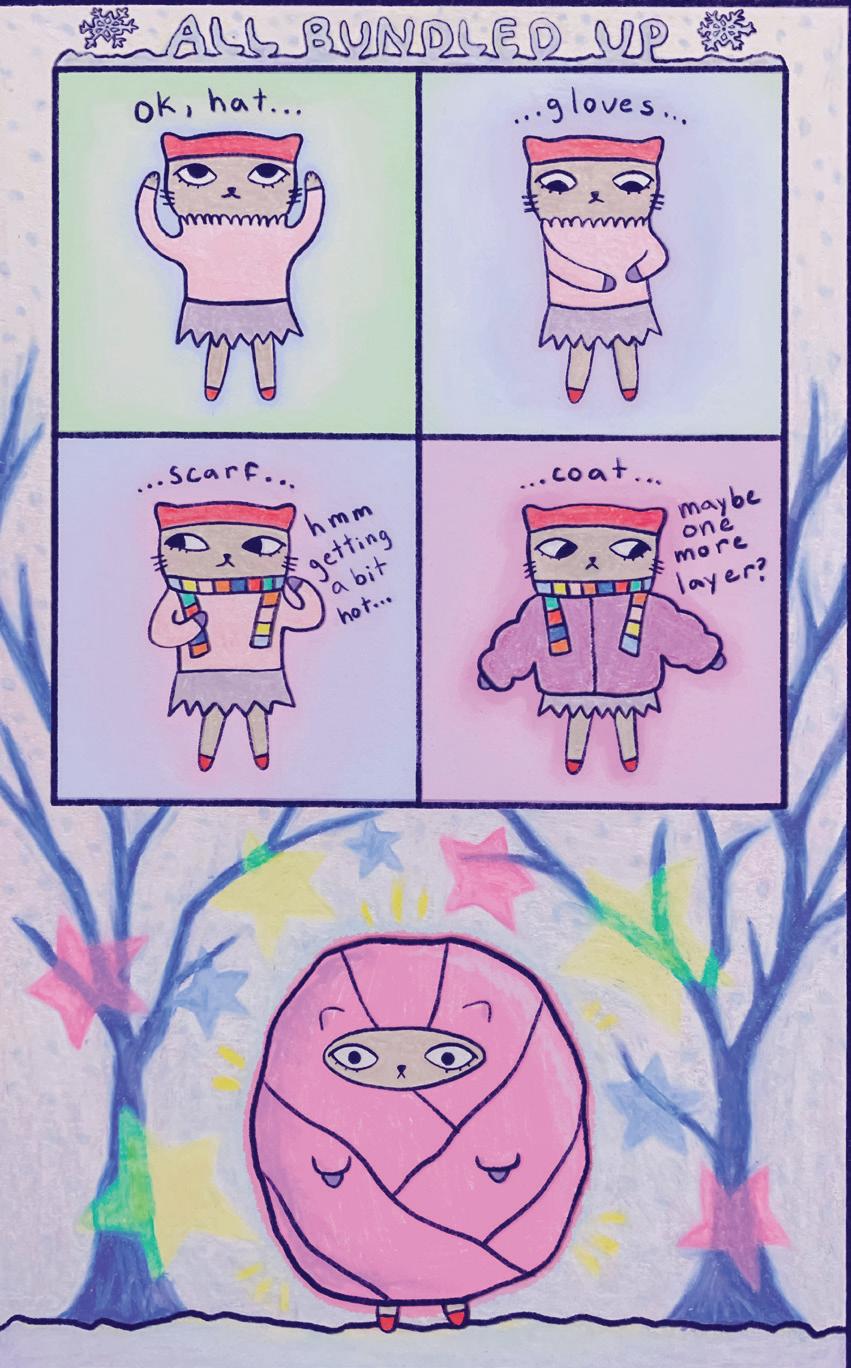

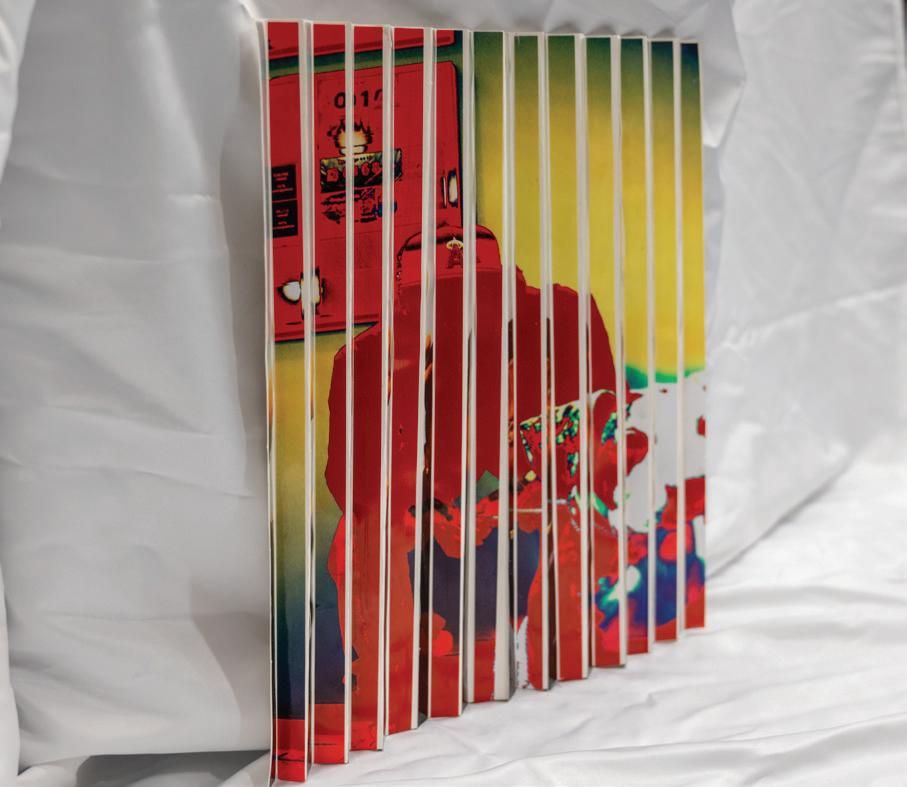


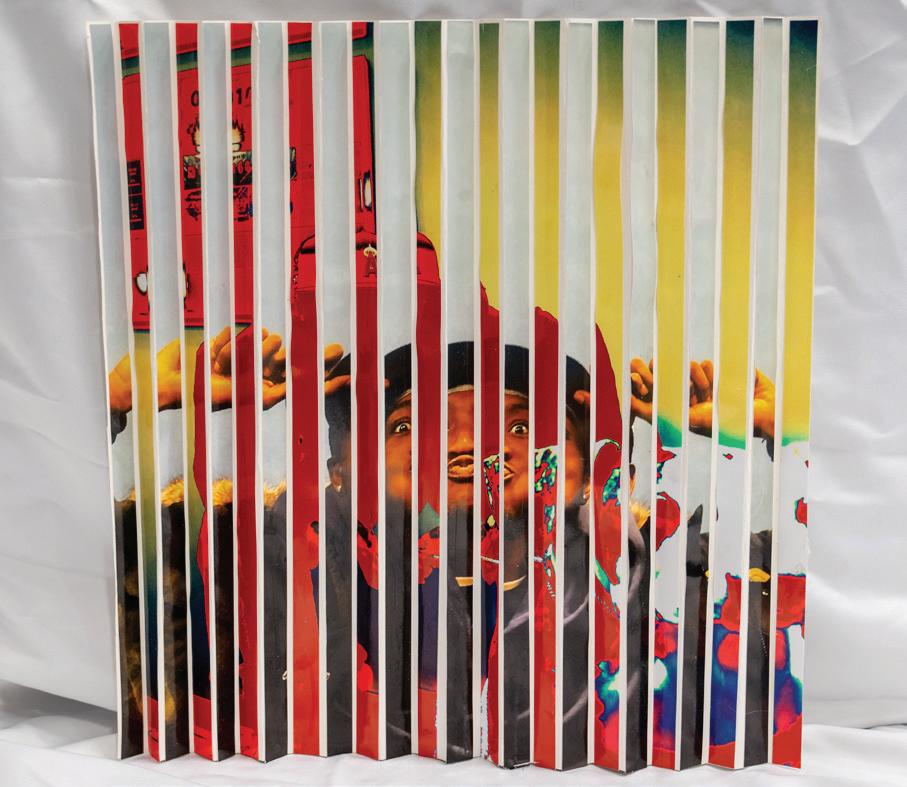

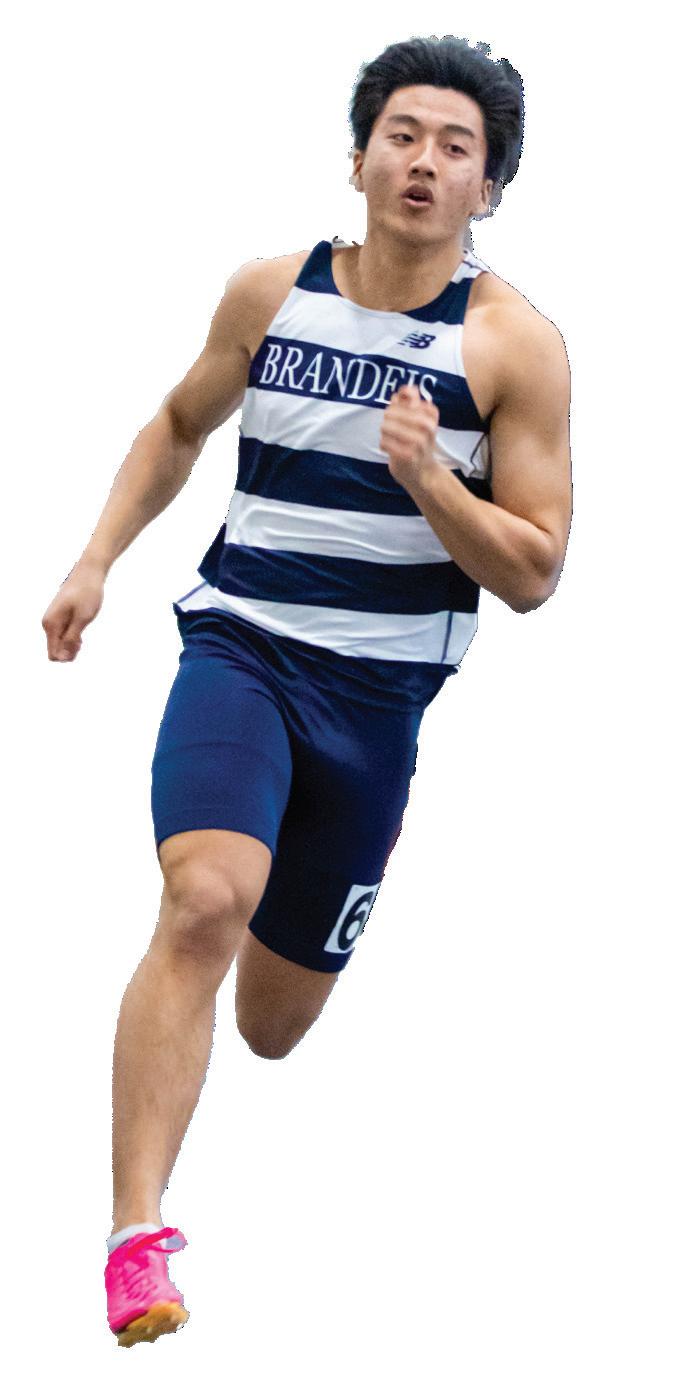
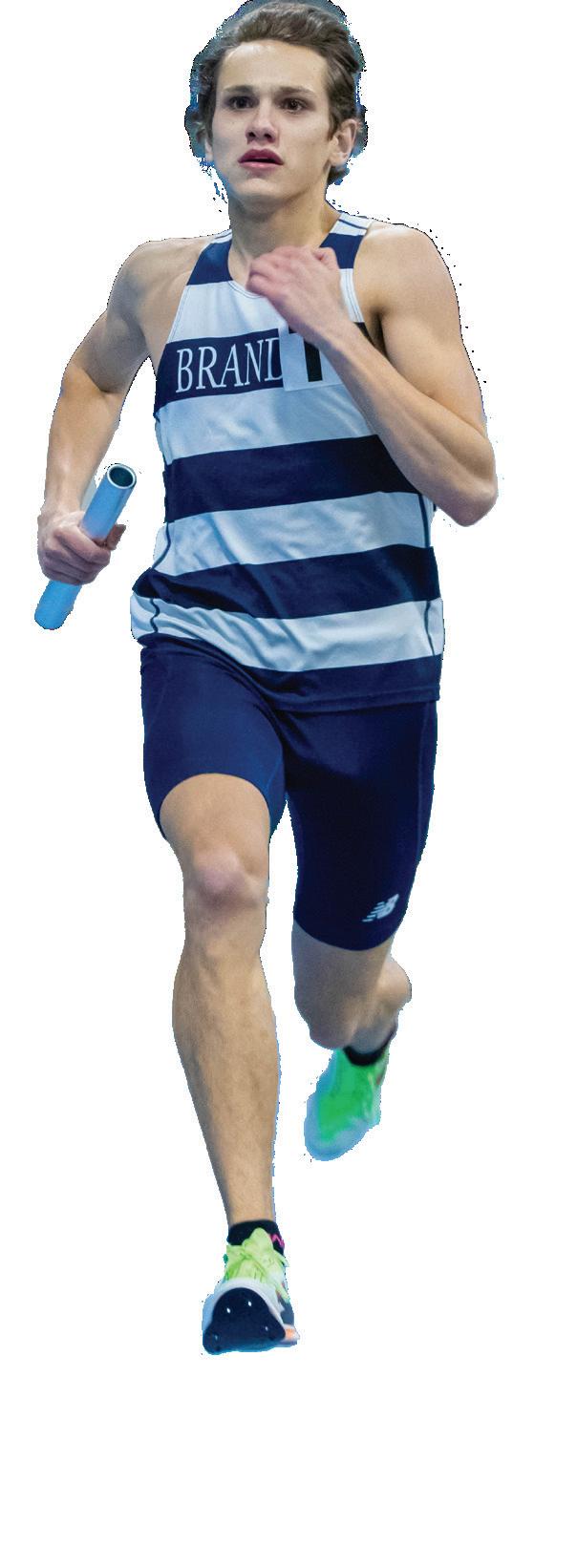

teams, scoring a total of 129.5 points. The men placed third out of nine teams, scoring 80 points total.
The two teams combined had with nine first place finishes: TJ Carleo ’26 in the 1,000 meter run with a time of 2:34.02; Willem Goff ’24 in the 3,000 meter run with a time of 9:15.97; Smiley Huynh ’24 in pole vault with a height of 3.55 meters and long jump with a distance of 5.05; Sam Kim ’24 in the 600 meter run with a time of 1:24.68; Kirsten Man ’25 in high jump with a height of 1.56 meters and triple jump with a distance of 10.99; Olivia Zarzycki ’24 in the 600 meter run with a time of 1:42.89; and the 4x400 meter relay with Hannah Bohbot-Dridi ’25, Zarzycki, Natalie Liapis ’27 and Ifigenia Oxyzolou ’26 running a time of 4:21.94. At their first of three meets at Tufts at the Branwen Smith King Invitational both teams had a rougher run despite some standout performances with first place finishes from Shaniece Nugent ’26 in triple jump with a distance of 11.29 meters and the 4x200 meter relay with Nugent, Man, BohbotDridi and Zarzycki. The women’s team placed fourth out of 13 teams scoring 62.5 points, and the men’s team placed seventh out of 11 teams scoring 28 points. The teams then split up to compete with the majority going to the Riverhawk Invitational, many throwers going to the Wheaton Invitational and select distance runners competing at the Boston University John Thomas Terrier Classic — all nonscoring meets. At Wheaton, the team season’s best in shot put and weight throw was made by Cam Peirce ’25 and Kevin Wright ’27 respectively. Returning to Tufts for the Cupid Challenge, another non-scoring meet, standout performances include Carleo’s second-place finish in the 800-meter run with a time of 1:54.31, which converts to a 1:52.70, which at the time was the 16th fastest time in Division III run at the time earning him another UAA Athlete of the Week honor. Additionally, Nugent placed first in the triple jump with an at-the-time personal record of 11.31 meters. The team split again to compete at both the Boston University David Hemery Valentine Invitational and the Massachusetts Institute of Technology Gordon Kelly Invitational. At BU, many team season’s best were made including in the 200-meter dash by Dean Carey ’25 with an indoor personal best time of 23.03 and at the time team best and personal best by Nugent with a time of 26.67, and Carleo running another 800-meter dash at 1:51.58 pushing him at the time to 8th in the Division III. At MIT, Huynh ran an at-the-time team best in the 60-meter dash with a time of 8.24, matching her personal record. At Wheaton College’s Pre Post Season leading up to the conference meet, firstplace finishers included Garret Rieden ’26 in the 800-meter run with a time of 1:55.96; the 4x400 meter relay
consisting of Bohbot-Dridi, Zarzycki, Nugent, and Elizabeth Korn ’24 with a time of 4:07.70; Man in the high jump with a height of 1.51 meters; Huynh in pole vault with a height of 3.55 meters; Nugent in triple jump with a distance of 10.59; and Anna Batelli ’25 in the 3000 meter run with a personal best time of 10:51.19. For this effort, Batelli also ran a team season best. Additionally, many of the team’s season’s best were made, including in the 60-meter dash by Huynh with a personal best of 8.19 and Matthew Yue ’26 with a personal best time of 7.22. Yue also got a collegiate personal best in the long jump with a distance of 6.20 meters. In the 60-meter hurdles, TJ Showstead ’26 had a personal best time of 8.95 and in the 800-meter run, Zarzycki ran a personal best time of 2:24.22. In New York City at The Armory, the UAA Indoor Championships were hosted by New York University and lasted two days. Both teams finished in seventh, with the men’s team finishing with 12 points and the women’s team finishing with 18 points, a disappointing finish as many athletes placed just outside the scoring finishes. The men’s team had eight points scored by Carleo for his second-place finish in the 800 meter dash with a time of 1:52.37, two points scored by the distance medley relay consisting of Kim, Jonathan Wey ’27, Adam Rieden ’26 and Hugh Licklider ’27, and a final two points were scored by the 4x400 meter relay consisting of Carleo, Kim, Deandrea Williams ’27 and Wey with a time of 3:32.46. The women’s team had two points scored by Bohbot-Dridi in the 400-meter dash with a personal best time of 59.32; one point from Alya Campbell ’24 in the 60-meter hurdles with a time of 9.29; two points from the distance medley relay consisting of Sadie Harrow ’27; Liapis, Ella Warkentine ’26 and Lizzy Reynolds ’24 with a time of 13:08.67; two points from Man in the high jump with a height of 1.53 meters; one point from Alisha Anderson ’26 in the pole vault with a height of 3.36 meters; five points from Nugent in triple jump with a personal best distance of 11.42 meters; and another five points from the 4x400 meter relay consisting of Bohbot-Dridi, Korn, Nugent and Campbell with a time of 4:01.34. At their third and final time for the indoor season, the Judges returned to Tufts for the Last Chance National Qualifying Meet in which many team season’s best were made including Yue in the 60-meter dash with a personal best time of 7.14, Campbell in the 60-meter hurdles with a personal best and school record matching time of 9.21, Man in the high jump with a personal record height of 1.64 meters and Emma Liu in weight throw with a personal best distance of 13.87 meters. Coming into the Division III National Championship, Carleo was seeded 11th in the 800-meter run. However, he ran his slowest time of the season-1:54.33-and ended up in 18th. Despite the low-placed finish for the indoor season, the team is not far from making improvements to come back stronger in the outdoor season and is hopefully setting their sights for better performances in both the UAA conference and regional championships.
— Editor’s Note: Justice managing editor Smiley Huynh ’24 and Justice News editorial assistant Lin Lin Hutchinson ’25 are members of the track and field team and did not edit nor contribute to this story.

The Brandeis men’s basketball team opened head coach Jean Bair’s 6th season with an 86-77 win over University of Massachusetts Dartmouth. The Judges shot the ball exceptionally well at 61% from the field and 54% from 3. Beginning their three-game road trip at Rivier University, they dropped the first game 56-73. The Judges then fell 65-78 versus Babson College. Neither team shot the ball well, but a cold stretch from beyond the arc saw the men’s team fall behind and never catch up. Brandeis capped off their road trip with a win over Rhode Island College, 66-51, behind 18 points from guard Sam Adusei ’24, tied for a career-best. Tied at the end of the first half, Adusei scored 16 of his 18 points to put the Judges up for good in the second. The men’s team then cruised to an 83-48 victory versus Plymouth State University. Six players scored for Brandeis in double-digits while the Judges’ defense held their opponents to 32% from the field and forced 25 turnovers. To begin the 2023 UAA Challenge Tournament, Brandeis beat Bates College 68-58 in a wire-to-wire victory. Versus Colby College, they won 77-57. Guard Jake Bender ’26 recorded a double-double with 12 points and 13 rebounds while forward Quron Zene ’26 and Adusei both put up 15 points in the convincing win. The Judges continued their winning ways in a 62-57 comeback win over Lasell University. Trailing by six points midway through the second half, the Judges went on an 11-0 run to put them up for good. Adusei topped his career-high with 19 while Zene put up 18 off the bench. At Salem State University, a strong first half saw the men’s team improve to 7-2 with a 74-55 win. Trailing by 5 at the end of the first half, strong defense saw Brandeis come from behind versus Middlebury College to win 6560. They forced 10 turnovers in the second half, and guard David Perez-Miralles ’24 recorded six steals in 17 minutes. Brandeis extended their winning streak to eight straight with a 76-59 road win over Regis College. Center Aeden Using ’24 pulled down 11 rebounds in a game where the Judges never trailed. To open UAA play, Brandeis fell 52-70 to #6 New York University before recording their first con-

ference win at Carnegie Mellon University 78-61. Guard Gilbert Otoo ‘25 had a team-best 20 points and 10 rebounds in the victory. The Judges then fell to #5 Case Western Reserve University 76-77 on the road. After falling behind in the final minutes of the second half, they were unable to capitalize on their final opportunities to take the lead. A poor shooting performance at home saw the Judges lose versus Chicago University, 55-72 before rebounding 59-54 in a low-scoring affair versus #14 Washington University in St. Louis. Zene had 20 points on four made three-pointers and Adusei added 15 points of his own alongside nine rebounds. Versus #20 Emory University, the men’s team lost 65-78 and then shot 29% from the field in a 52-61 home loss to Rochester University. In a rematch on the road, the Judges held off a late rally from Emory to win 71-69 behind 20 points with 13 points from forward Matthew Cadogan ‘25. Facing Rochester on the road, the men’s team won a dramatic 75-72 contest after trailing by 20 to start the second half. A strong defensive showing saw the team force 19 turnovers en route to a 44-point second half. The Judges lost 77-80 versus Carnegie Mellon despite Otoo and Adusei’s 22 and 20 points respectively, when a three-pointer in the final seconds fell no-good. Versus Case Western Reserve University, the team lost 70-78. Forward and team captain Ryan Power ‘24 led the men’s team in scoring with 17. The Judges bounced back with a 76-71 victory over Chicago powered by 27 points and 7 made threes from guard Jake Bender ’26, the most points scored by any player on the team in a game all season. The Judges lost their final two games of the season, a 53-56 contest at Washington University and a 68-74 home game against New York University. The Judges finished their season 14-11 and 5-9 in conference play. At the end of the season, Otoo led the Judges in points per game at 11.2, while Using took home UAA Defensive Player of the Year, a huge honor for the program. Otoo also took home a UAA Honorable Mention selection. For the 2024-2025 season, seven players who played significant minutes will be returning, as will forward Toby Harris ‘25, who had three productive games this season before being sidelined with injuries.


The women’s team began their season under acting head coach Jill Latanowich with a strong 61-38 win over Wellesley College, including a 25-point first quarter in the Judges Invitational Tournament. Forward Brooke Reed ’26 went a perfect 6 for 6 from the field and led the team with 13 points. They then fell 46-77 to Oberlin College in the tournament title game, shooting a tough 20% from the field. Versus Eastern Nazarene College, they lost 59-70. Forward and team captain Caitlin Gresco ’25 had 16 points while forward Molly James ’26 had 10 points and nine rebounds off the bench. The Judges battled in their first road game at Tufts University, but a tough third quarter saw them lose 61-88. The next game, they struggled from the field in a 44-79 loss to Babson College. Versus Roger Williams University, the team lost 58-64. Guard Selenya Gonzales ’24 led the Judges with 16 points. The team responded with a 72-63 road win at Rivier University. Four Judges scored in double digits, with forward Katherine Vaughan ‘26 scoring 21 points and 9 rebounds. At the Massachusetts Institute of Technology, they lost 60-77 before an 88-72 win at Salem State University. The team made 15 threes and James pulled down 14 rebounds in the high-scoring affair. The Judges followed this up with an 80-79 victory over Bridgewater State University. Vaughan put the Judges up 80-79 in the final 10 seconds on a layup and guard Lulu Ohm ’26 had a steal in the final 2 seconds to ice the game. The Judges lost their next game 72-84 versus Clark University. They lost their conference opener 52-103 versus New York University before losing 54-73 at Carnegie Mellon University. At Case Western Reserve University, Gresco led the Judges
with 14 points, but the team lost 53-64. The Judges began a four-game home stand with a 53-65 loss versus the University of Chicago. A rough shooting night saw the team fall 48-83 to Washington University in St. Louis. Three players scored in double digits, but the Judges lost 57-81 versus Em ory University. The team dropped their next game against Rochester University 60-78. A rough 3 for 20 night from beyond the three-point line hampered the Judges in their road rematch against Emory that ended 50-76. After a tied first quarter, the women’s team fell behind in the second quarter and lost 51-83 at Rochester. The Judges notched their first UAA win in a nail-biter versus Carnegie Mel lon. Trailing 13 points towards the end of the third quarter, Ohm had seven points and three assists in the fourth and forward. Claire Candela ’27 made two three-pointers to put the Judges up late. An unsuccessful late rally from the Tar tans saw the Judges win, 72-70. The Judges fought hard in a 64-71 home loss to Case Western Reserve, but a 24-11 sec ond quarter proved insurmountable. Ohm led the scoring for both teams with 18 points. Their next game was a lowscoring 51-63 loss at the University of Chicago. On the road against Washington University, the Judges went 0 for 23 from beyond the arc en route to a 30-77 loss. With 2 blocks, Vaughan set the women’s team single-season record for the most blocked shots in a season. The Judges lost their final game of the season against New York University, 5481, but guard and captain Francesca Marchese M’24 made three-pointers to set a new program record for three-point shots made in a career. The Judges finished the season 5-20 and 1-13 in conference play. Gresko led the team in scoring with 10.6 points per game and Reed led with 6.7 rebounds per game. Gresko took home All-UAA Honorable Mention honors for the Judges.
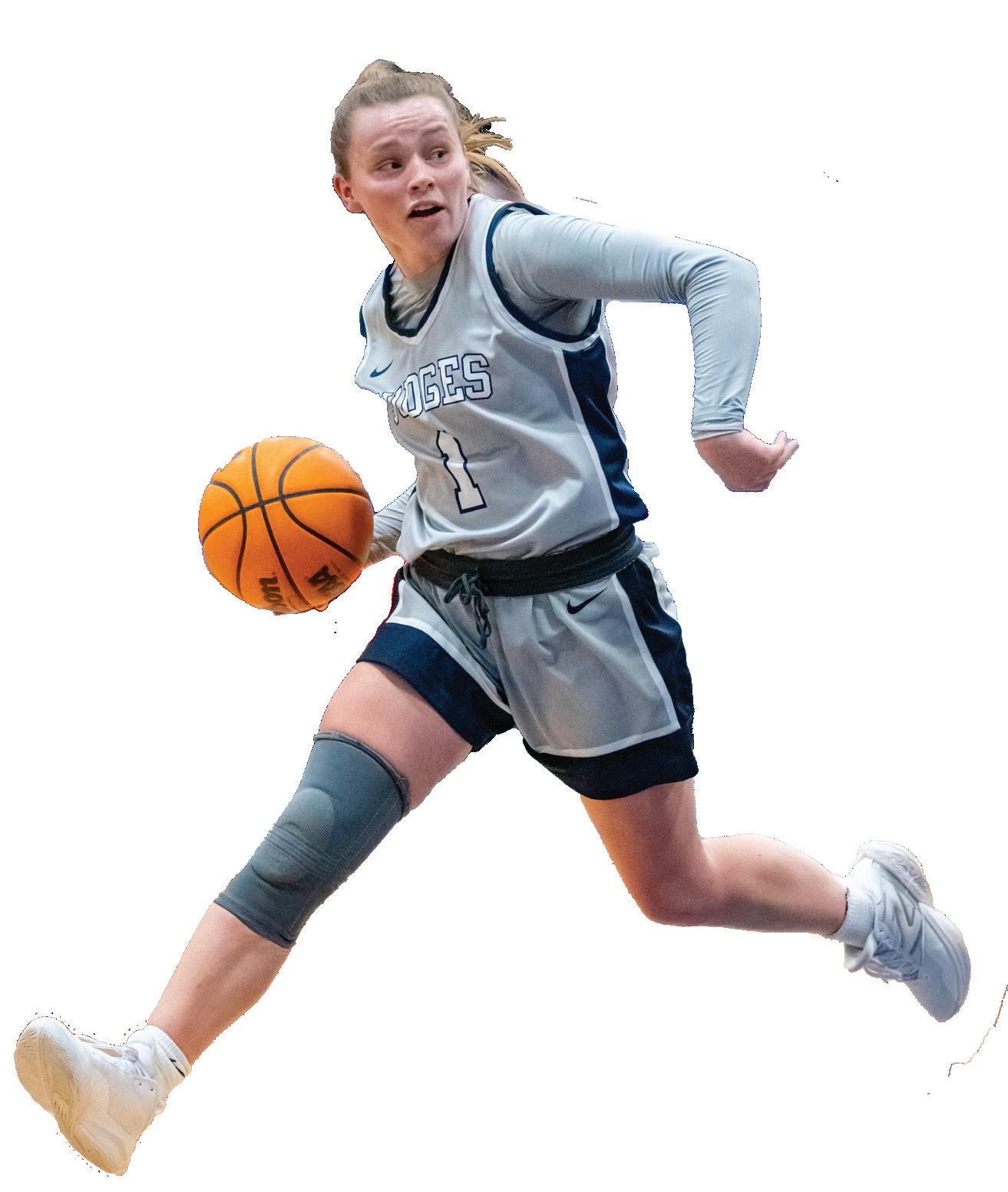



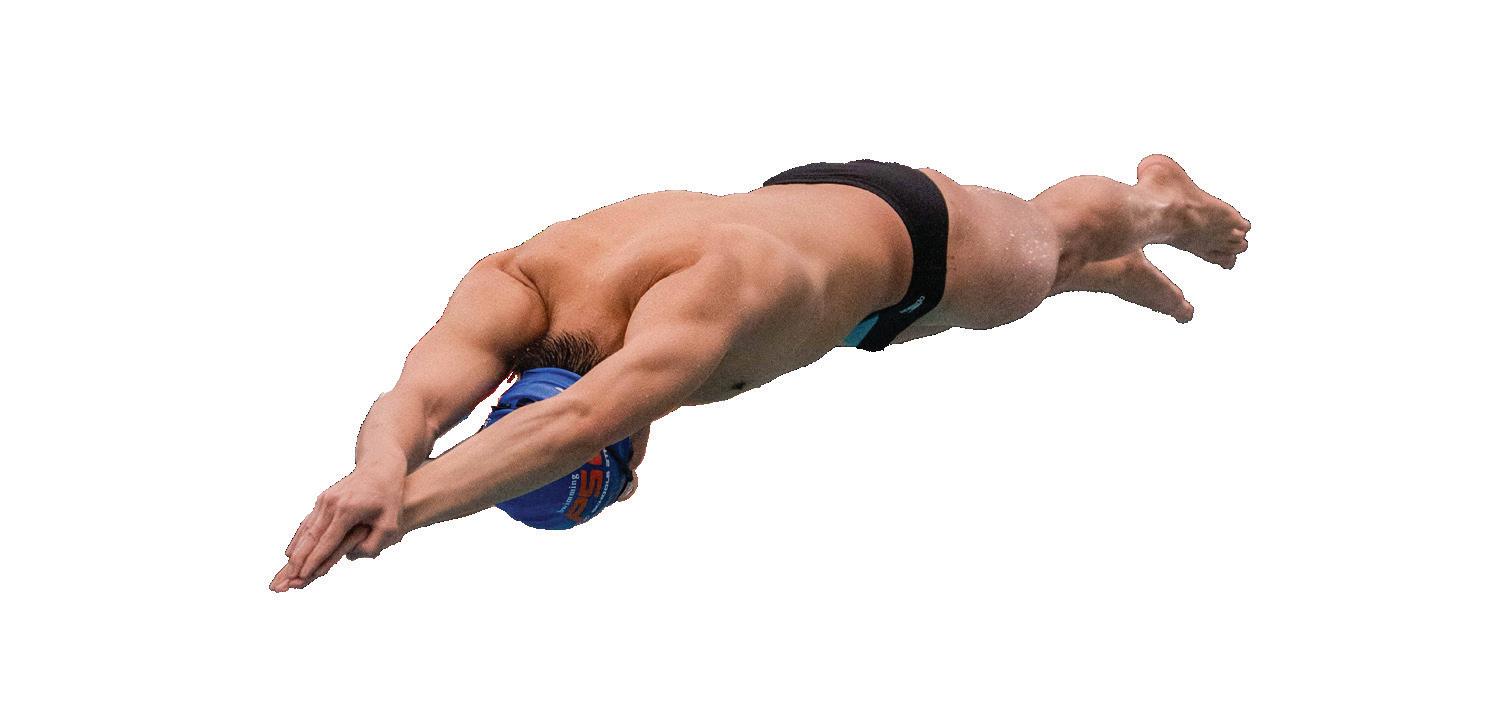 By MILES GOLDSTEIN JUSTICE STAFF WRITER
By MILES GOLDSTEIN JUSTICE STAFF WRITER
The men’s and women’s swim and dive teams began their seasons with a meet at Hartwick College. The women’s team won eight of ten events, placing first, while the men’s team placed third. The women’s team won the 800yard freestyle relay by 10 seconds with a time of 9:30.02. The men’s side captured a victory in the 850-yard relay with a time of 7:48.40. Dominique Goodman ’27 placed first in the 1-meter dive with a score of 208.90.



Men’s Tennis
Institute of Technology
Apr. 6 New York University
Apr. 10 Coast Gaurd Academy
Apr. 12 University of Mary Washington
The men’s team came away with a victory in the second joint meet versus Vassar College. Sam Dienstag ’24 won the 1000-yard freestyle by nearly a minute in one of his two victories that day, while the women’s team took a victory in the 200-yard relay by just two-hundredths of a second, posting a time of 1:28.22. Goodman also had two wins in diving competitions at the meet. The next competition was a multimeet, with the men’s team and women facing Worcester Polytechnic Institute, Babson College and the United States Coast Guard Academy. The women’s team additionally competed against Smith College. In head-to-head scoring, the men’s team lost to all three schools, while the women’s team beat Smith and lost to the rest. Monika Iizuka ’24 and Benjamin Lee ’26 each had two second-place finishes, making them two of the highest-performing Judges at the meet. Against Bentley University, the men and women won six of 32 possible events. The next meet was against the #24 ranked Coast Guard Academy. The women’s team won five events, while the men’s team were unable to capture any. Josie Kearns ’27 had victories in the 1-meter and 3-meter dive. On the road against #17 Tufts, the women’s team scratched out one victory while the men’s team was unable to record one. The next meet was the three-day Gompei Invitational at Worcester Polytechnic Institute. On day one, Benjamin Lee ’26 posted the second fastest time in school history in the 200-yard medley with 1:54.13. Audrey Teo ’26 broke the school’s top ten times in the 200-yard breaststroke with a time of 2:33.30. Iizuka was a top performer for the Judges on day two, with a time of 26.55 on the 50-yard backstroke. On day three, the women’s team had nine different swimmers place in the top 20 in their events as the Judges wrapped up the tournament, placing eighth overall. The women’s team then faced off against Stonehill College. Two swimmers recorded victories as the Judges lost 104-61.
The next joint meet on Senior Day saw the teams face off against Bridgewater State University and Keene State University. The women’s team beat both schools, while the men’s team had a victory over Keene State but lost to Bridgewater State. The Judges had nine members of the team record wins that day. In the last regular season meet at Clark University, the teams won 26 of 31 events, including all the relay races. The UAA Championships took place at the University of Chicago. Dienstag recorded the first Gold for the Judges in almost 20 years with a victory in the 500-yard freestyle. Moderate success on day two saw the teams maintain their position at eighth place in the competition. Dienstag took home his second All-UAA honor on the final day, placing second in the 1650-yard freestyle. On the women’s side, Chloe Gonzalez ‘26 had the second best time in school history in the 100-yard freestyle with 52.91 seconds. Both teams finished the event in eight place. Looking ahead, Diensteg will be competing in the NCAA Division III championships on March 20th.